Deep Dive: Cases
OHSC: original hard shell case. You see it in ads all the time: “with OHSC”. It’s a selling point. It adds value to the guitar. But how do you really KNOW if it’s the ORIGINAL hard shell case?
Well there’s no way of REALLY knowing, is there? Guitars get separated from their “original hard shell cases” all the time for all sorts of reasons. Hell, you’ve probably sold a guitar and realized after the fact you shipped it in the wrong case! And cases themselves change throughout the life cycle of a specific instrument just like the guitar itself does. Maybe “original era-correct, factory-supplied case” is the best we can realistically hope for. But OECFSC doesn’t have the same ring though, does it?
Regardless, an OHSC or OECFSC (okay, that sucks, I’ll drop it. You know what I mean when I say OHSC) DOES add value to a guitar. So how do you know if that’s what you’re getting? Trust me, you’re gonna find plenty of guitars with a case that’s straight up wrong, or with one that looks like it maybe could be?, or with one that’s “factory issue, wrong era”. Well, after this you ought to have a pretty good idea of what to look for.
And—quick note—holy crap was this hard! I started working on this like six months ago and have looked at literally THOUSANDS of pictures of guitar cases. I never want to zoom in on a fuzzy picture of fuzz again! Am I 100% confident of my results. Nothing’s ever 100% certain with Rickenbacker. Am I as confident as I can be? I guess? I’m sure something’s wrong here. Spot it, tell me what it is, and I’ll set the record straight. I should also point out that this is LONG. Make sure you have a comfy seat.
But before we dive right in, let’s throw out a handful of terms that will be important as we talk about cases. We’ll start with “standard” and “deluxe”. From the late 1950s to the early 1980s Rickenbacker offered both standard and deluxe cases—although not always both. In general, “standard” cases had minimal interior bracing and padding, and no interior storage compartment. “Deluxe” cases had—at the bare minimum—an interior storage compartment, and usually more padding and internal bracing.
There is no direct correlation between deluxe/standard cases and “Deluxe/Standard” models however—you will find “Standard” 330s with “deluxe” cases and “Deluxe” 360s with “standard” cases. Indeed, some “Deluxe” guitars did not even have a deluxe case offering. For a long time cases were ordered separately from the guitar—usually by the dealer—and unless you custom ordered a specific case you likely got whichever case your dealer had ordered from Rickenbacker along with the guitar. In some cases, dealers even bought their OWN cases from their own suppliers because they could get a better price going directly—the guitar never HAD an “OHSC”.
Next, when we talk about guitar case cover materials there are two terms that you will see commonly used: Rexine and Tolex. Rexine is a “leather cloth”, which is to say fake leather. In a leather cloth, a layer of cloth is covered with a plastic material (often cellulose) embossed to look like leather. The name “Rexine” was a brand name of—wait for it—Rexine Ltd, a British manufacturer. Similarly, “Tolex” was a brand name of General Tire, and the product was the same basic idea: a layer of cloth, covered this time with vinyl, and embossed with a pattern that’s usually “leather-esque”.
Rexine dates to the 1920s, Tolex to the 1940s. Because of the improvements in polymer science in the time between their invention, Tolex is more durable than Rexine so over time most companies moved from Rexine to Tolex. Now, plenty of other companies made leather cloths and vinyl coated cloths. But we use the brand names Rexine and Tolex generically today to indicate which “type” of material was used.
Finally, when we talk about case interiors we’ll talk about three types of material. First are our two velvets: “crushed velvet” and “velveteen”. Both are soft, piled, plush fabrics, but crushed velvet has a longer, textured pile whereas velveteen has a very short, smooth pile. Our third interior material is just plain “plush” material, by which we mean a plush long pile fabric that can vary from short pile and wooly to long pile and fuzzy—and anything in between!
Now we’re NOT gonna talk about latches and handles and that level of detail—going as deep as I have almost killed me as is! If you just HAVE to know that level of detail, well, there might be something wrong with you!
Now that we have the terminology down, let’s talk about “eras” and what to look for from each.
1957-1961: The Elephant Case Era
Our story begins with the Victoria Luggage Company. Victoria was a California company who produced all kinds of traditional fabric-covered wood cases, and they were pretty much the go-to case supplier for west coast guitar manufacturers like Fender and Rickenbacker in the 1950s and 1960s. And even earlier, in fact, as they began supplying cases to Rickenbacker in the 1940s for console/lap steel guitars.

So when Rickenbacker launched their first “modern Spanish electric guitars” in 1954–the Combo 600 and Combo 800–it only made sense that Victoria would provide those as well. Victoria would go on to be Rickenbacker’s primary case supplier for the next twenty years.

You’ll note only one case option for the Combo 600 and 800 is listed on the price list, with no “deluxe” or “standard” classification. We’re going to call it a deluxe case based on its features. There was also a “padded bag” listed, but I’ve never seen one. Doesn’t mean they never existed…but I suspect that to be the case.
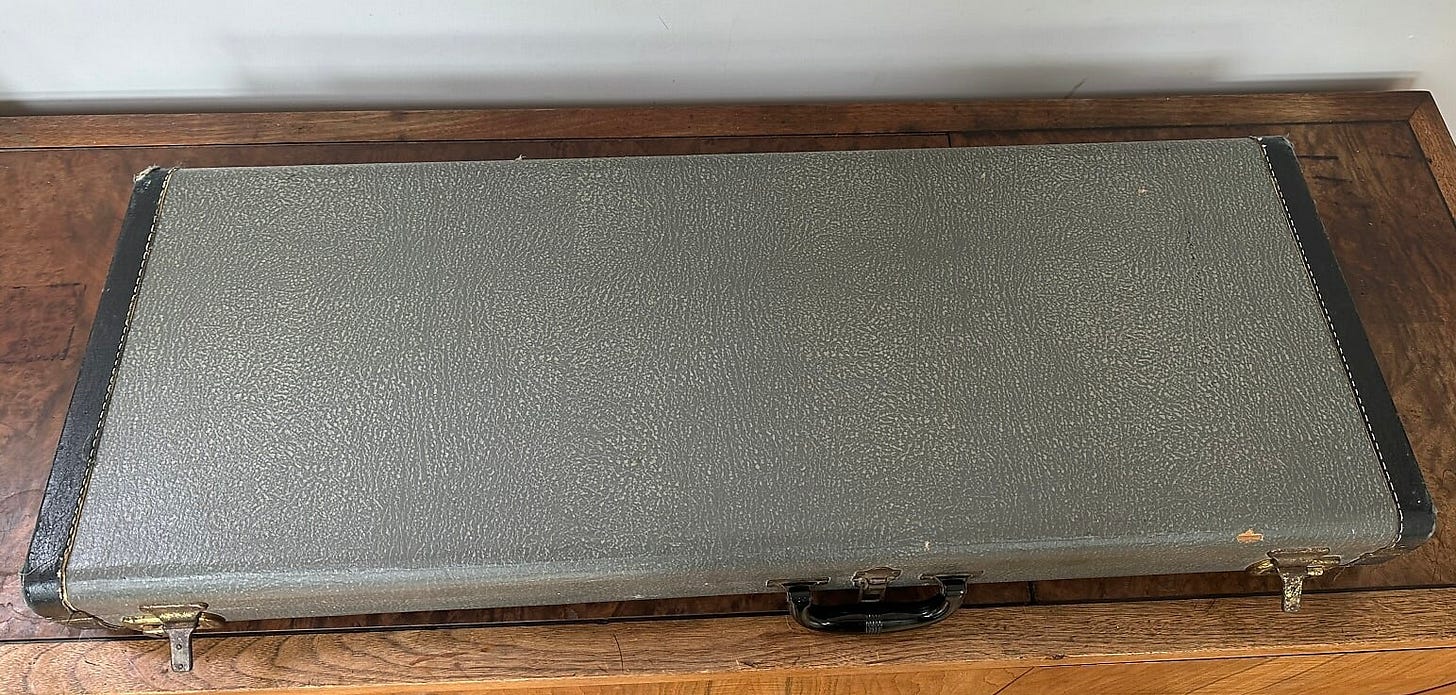
These early cases are often referred to as “elephant cases” because of their gray (officially “Stag Grey”) Rexine covering that kinda looks like…elephant skin. They also featured black ends with white piping and stitching—although the black leather ends on the Combo 600 and Combo 800 cases are a little bit narrower than on later cases, with only a single row of stitching versus the double row that would become standard.
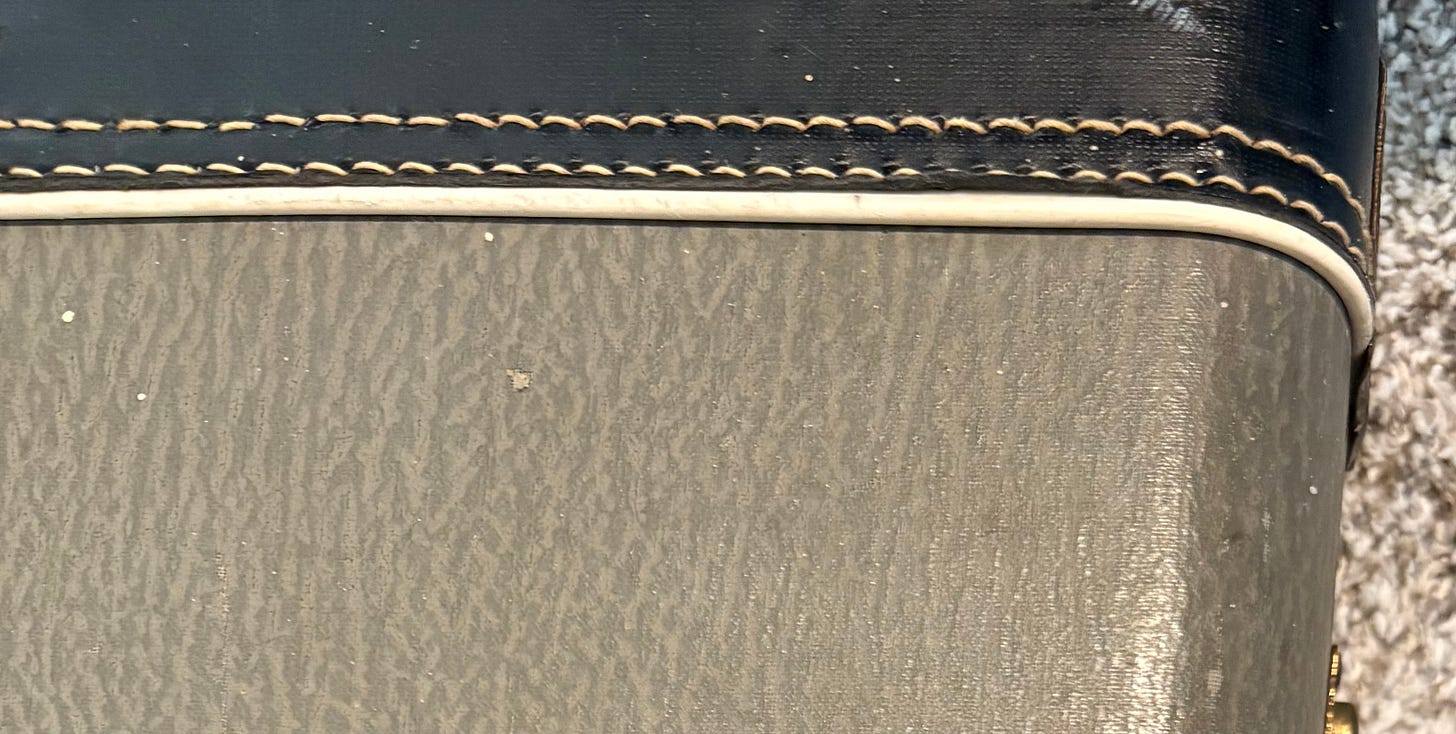
The Combo 600 and 800 cases got red crushed velvet interiors with neck support at about the 4th to 5th fret, a small storage compartment, and the body was held snug by form-fit contoured padding—pretty much a textbook example of a “deluxe” case from our definition above. The “look” of the first generation of Rickenbacker cases had been set!
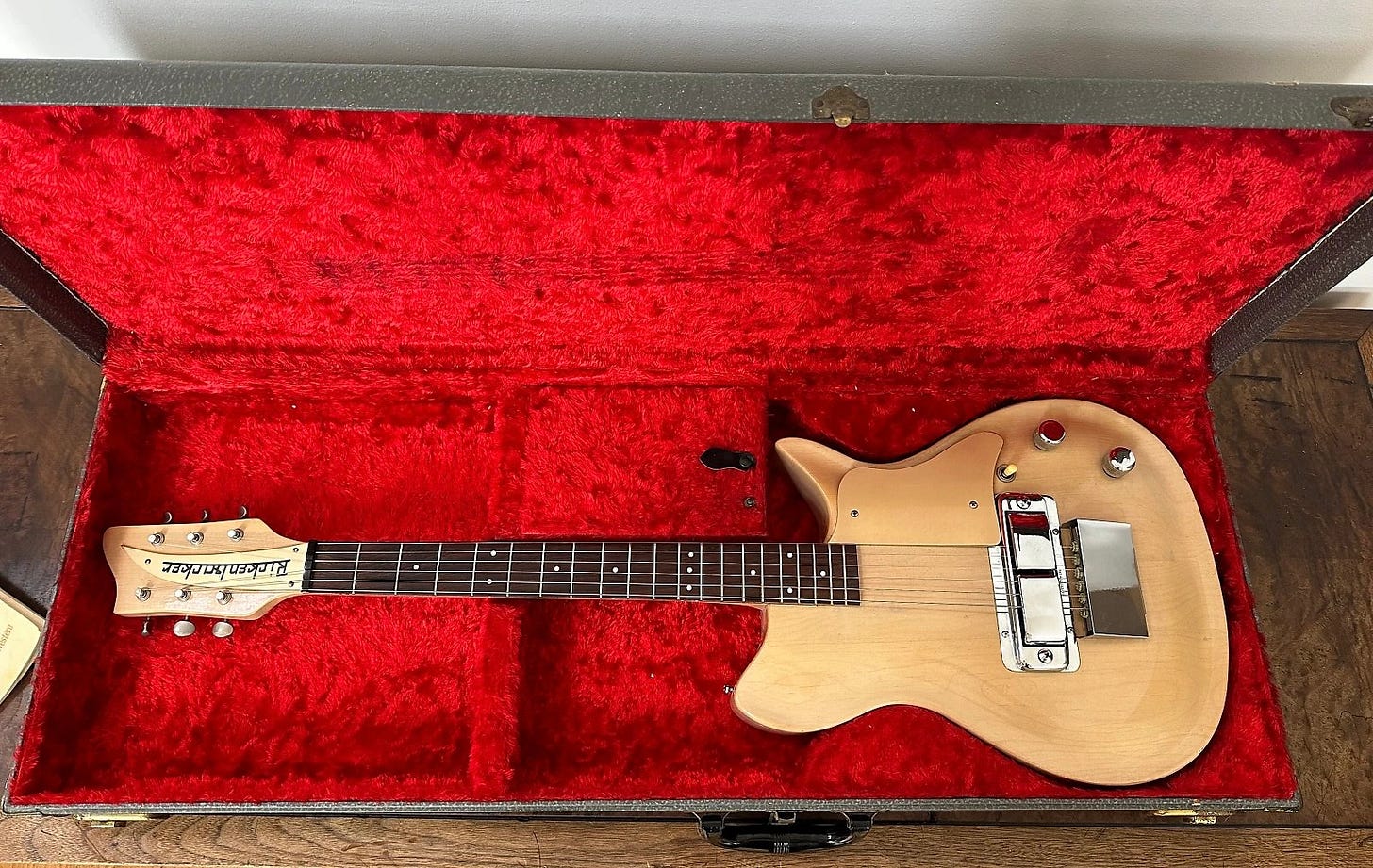
In 1956 came a new model—the Combo 400—and a new case for that model.

Just like the case for the Combo 600/800 it got no “level” designation, but with only a neck brace at the nut for internal support and no storage compartment or extra padding, it’s clearly what we’d call a standard case—even though it was the same price as the Combo 600/800 case! The outside is also slightly tweaked with wider black ends with double white stitching and white piping. This would become the norm moving forward.

The very next year the 400 got a deluxe case option for an extra $18— a $205 upcharge in today’s money!

Although this case lacked the form-fit padding the 600/800 case did, it was otherwise identical with a storage compartment and extra top padding, along with neck bracing around the fifth fret. Given the substantial upcharge, the option was not often selected.
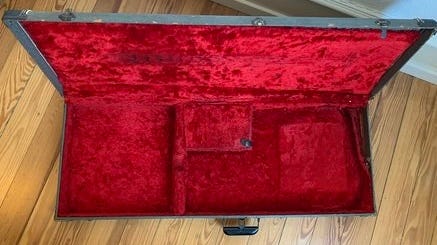
The new-for-1957 650 and 850 got a deluxe case that was very similar to the 400/450 deluxe case, but with the neck brace moved more towards the fourth fret and the storage compartment being above that brace instead of below like with the 400/450 case.

The form-fit padding of the Combo 600/800 case would turn out to be a bit of an outlier, as no deluxe case would offer this feature again for a number of years.
You’ll also notice from the price list cases for the 900, 950, and 1000 guitars in deluxe or chipboard option. Despite the “deluxe” designation, the construction of the short scale deluxe cases appear to be the same as “standard” 400/450 cases—albeit shorter—without a storage compartment or extra padding. It also appears that despite each model having its own case called out the same case was used for all three.
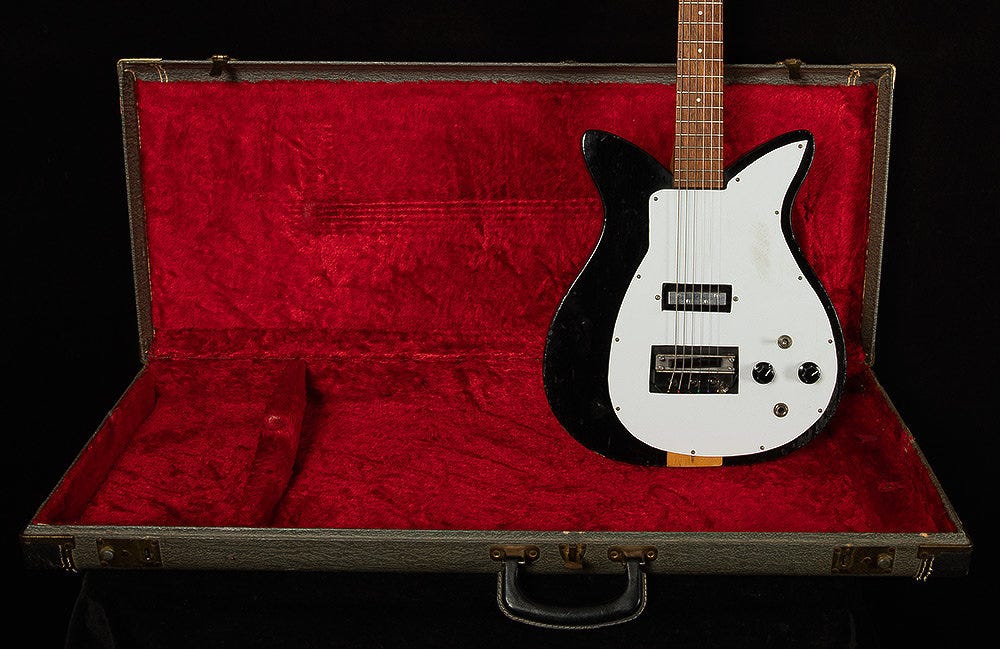
The chipboard case wasn’t vaporware, though. Here’s one right here! Note how a regular scale case was modified to fit a short scale guitar.
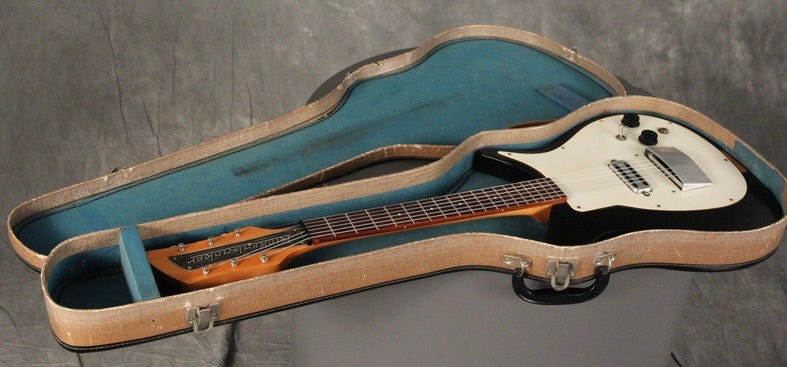
1958 brought a whole bunch of new guitars, and with them a whole bunch of new cases.

Now the first two cases are vaporware because the guitars they’re for are vaporware. You can read all about that here. But the rest are all real cases that really formalize the standard/deluxe scheme—still with gray elephant Rexine covering and red crushed velvet interior.
Well, kinda. You see, the short-scale Capris didn’t REALLY get their own, new cases at first—existing cases were reused. But not, as you might expect, the short scale solidbody case. It was not deep enough. The first “deluxe” short scale Capri cases? It’s the deluxe 400/450 case.
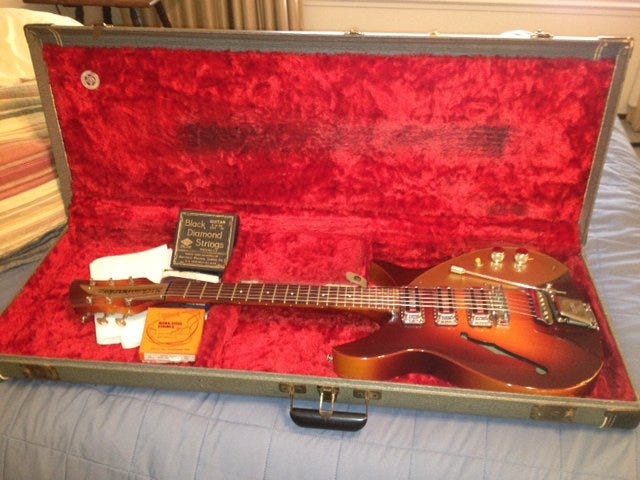
It’s not a full size Capri case—it’s too short and too narrow. And it’s not a custom made case—look how much room there is between the headstock and the case. It’s the preexisting 400/450 deluxe case…turns out the storage compartment was in exactly the right place to hold the body in place!
The standard case wasn’t new at first either. It looks like the standard 400/450 case was used at launch in 1958:

Some of these standard cases have been modified—probably after the fact—by moving the crossbar to allow the butt of the guitar to be supported.
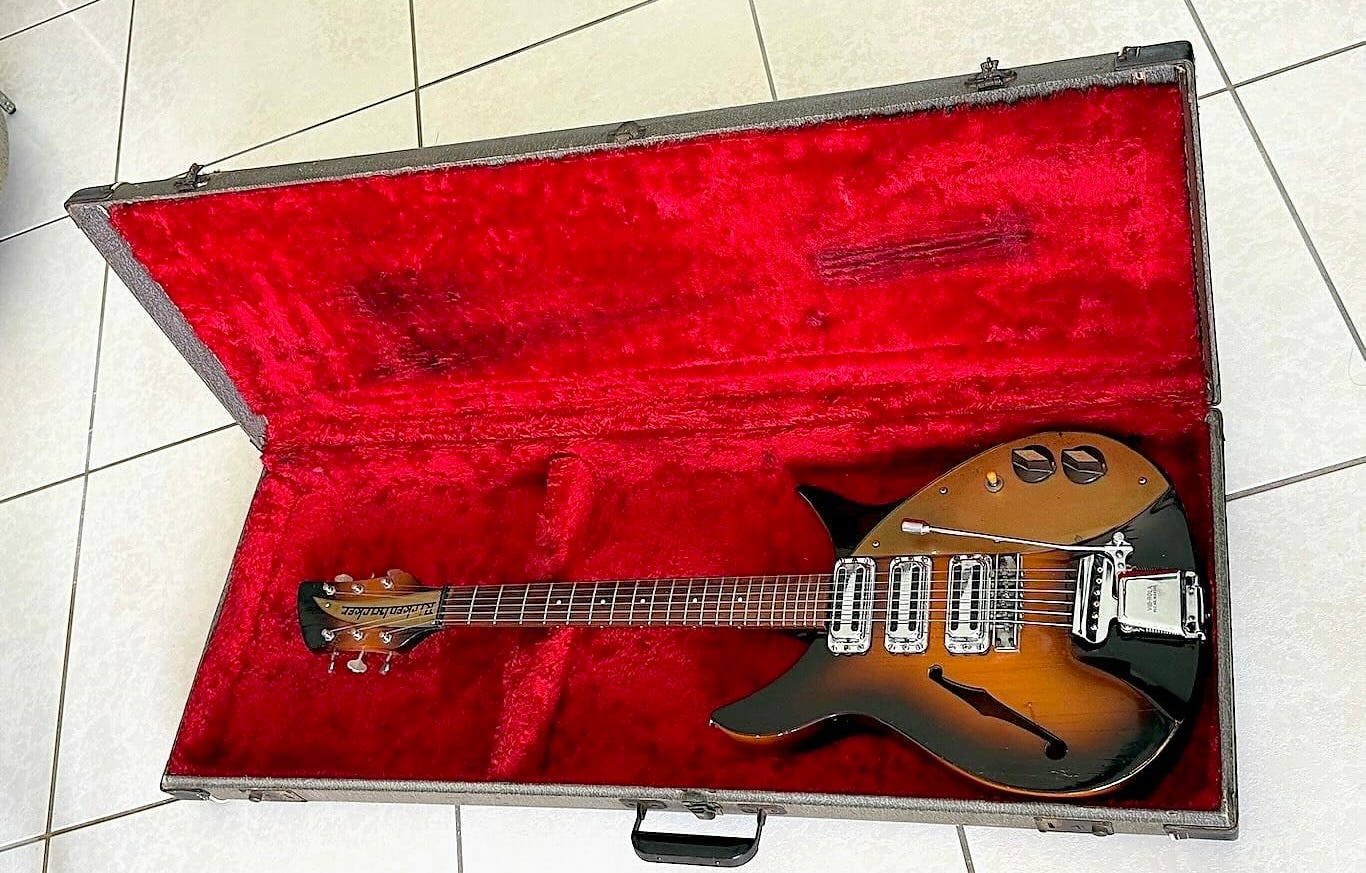
By 1960, when the last of the short scale Capris were built, they had transitioned to a purpose built case:

Despite being redesigned for 1958, the 450 and new 425 retained the same basic dimensions and therefore used the same “old” Combo 400/450 standard and deluxe cases.

Being much larger than any guitar currently in the line, the full scale 300 Capri models got their own new cases. The standard case matched other current standard cases with its grey elephant Rexine exterior and red crushed velvet interior with a neck brace at the nut/first fret.


The deluxe case featured extra padding, a large trapezoidal storage compartment, and a single neck brace at the 1st/2nd fret.
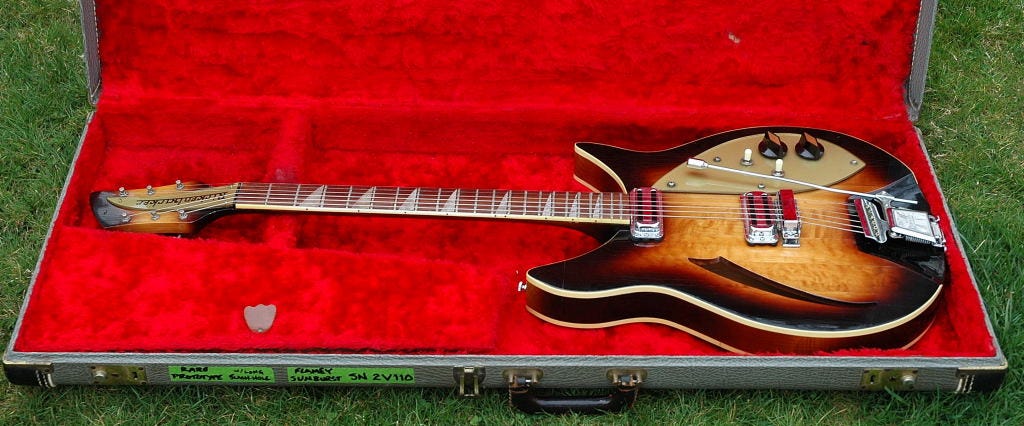
One final new model from 1958 got its own new case—without a deluxe or standard label, but with deluxe features—the 4000 bass.

There’s one more 1958 case that doesn’t appear on the price list. Because even though the F-body guitars wouldn’t officially appear until the 1959 price list, production actually began in late 1958. And the F-bodies were too big for any existing case so they got their own.
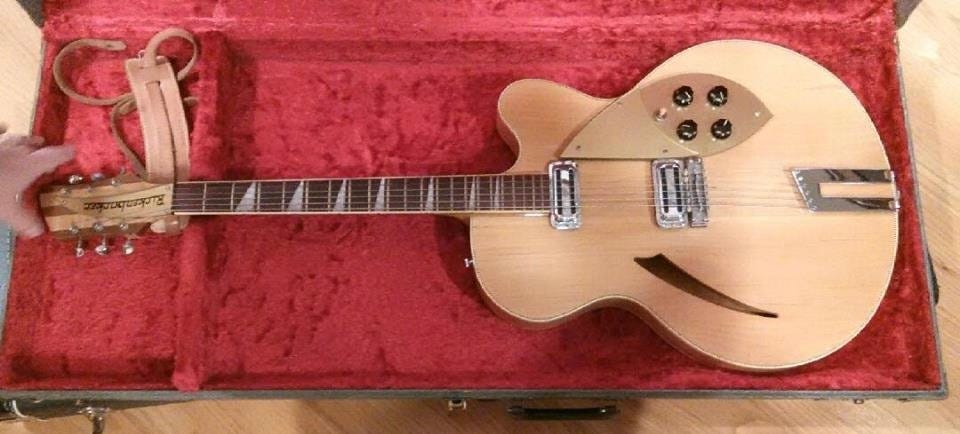
The F-bodies officially appeared on the 1959 price list, along with one case—not classified but clearly of “standard” specifications. There would be no further additions or changes until mid 1961.
1961-1962: The Transition to Tolex
1961 saw the launch of the “New Capri” models and, due to their thinner bodies, with them came a new case. But more than just a new case, we also got a new case covering. The “elephant” Rexine covering was replaced by silver Tolex.

The “New Capri” case came in two flavors—standard and deluxe—and featured the same red crushed velvet interiors as the older elephant cases.


From this point on, all cases would transition to silver Tolex. The first “elephant” case to make the change was the standard 400 series case in mid 1962:
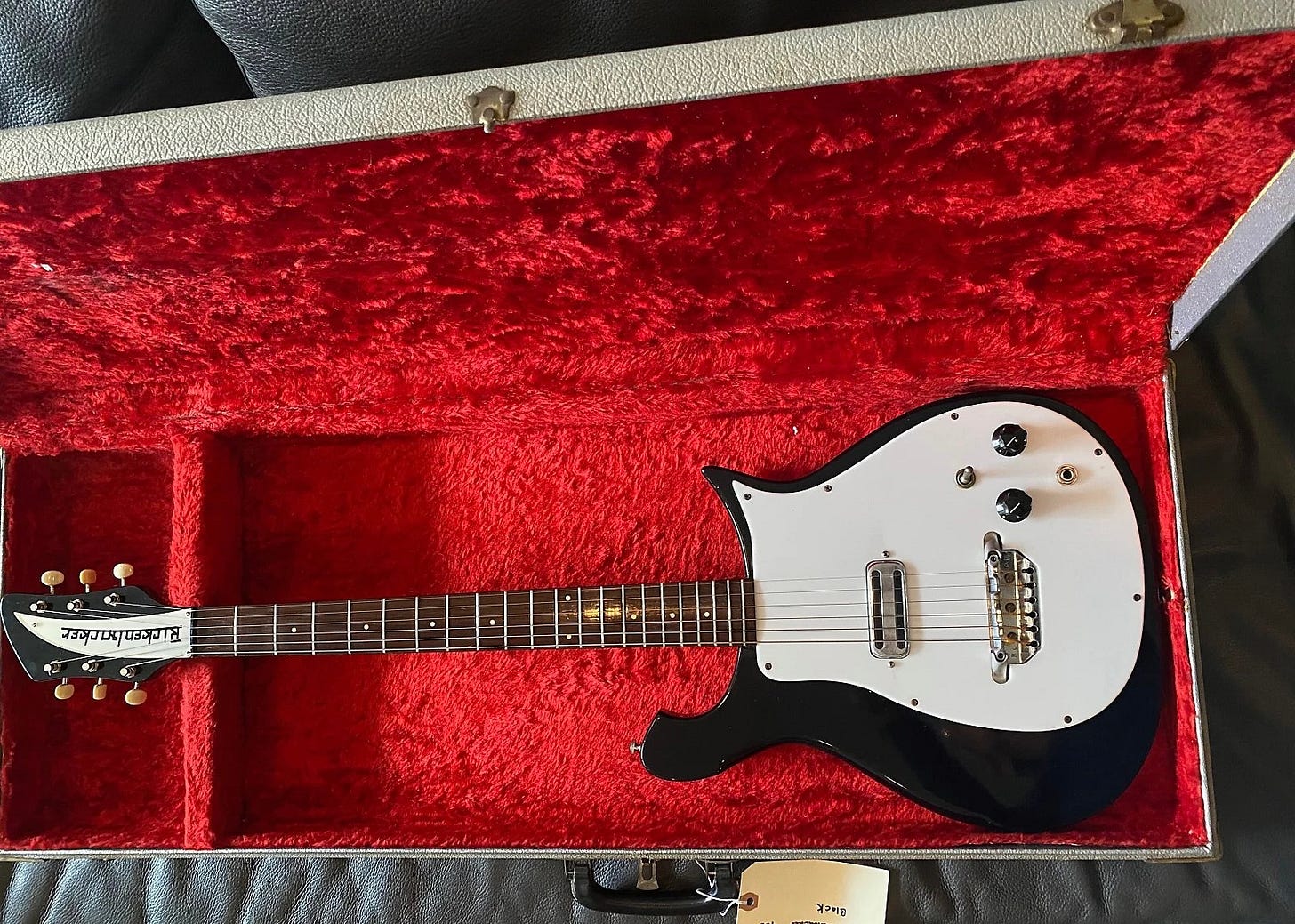
The same case would be used on the new-for-1962 625, no matter what the price lists say. For most of their lives the 400 and 600 Series guitars would use the same case.
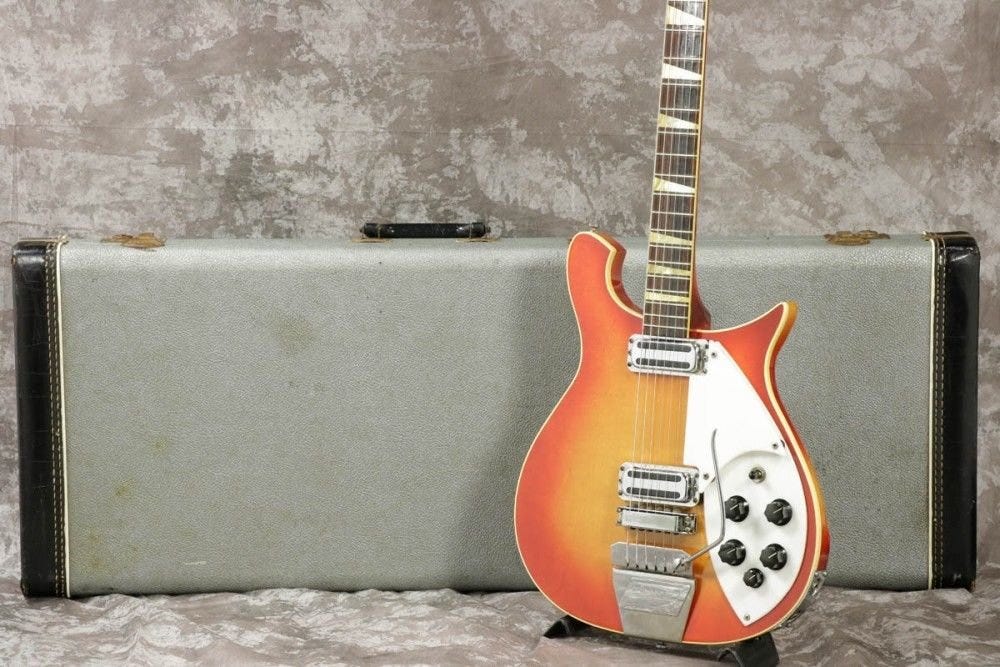
Although it would take until early 1963 for the new material to show up on all cases, the silver Tolex era had begun. The cases even had hang tags boasting about the new covering.


You’ll note the blue crushed velvet background in the picture above. It didn’t take long for that to replace the old red interior. As near as I can tell the standard 400/600 case was the only elephant case to get the silver Tolex/red interior combo during this period as other elephant case stock was depleted in later 1962/early 1963, it was replaced by silver Tolex and blue crushed velvet. There are a couple more silver/red crushed velvet cases we’ll talk about a little later. What we now think of as the classic combination had become the standard look for Rickenbacker cases.
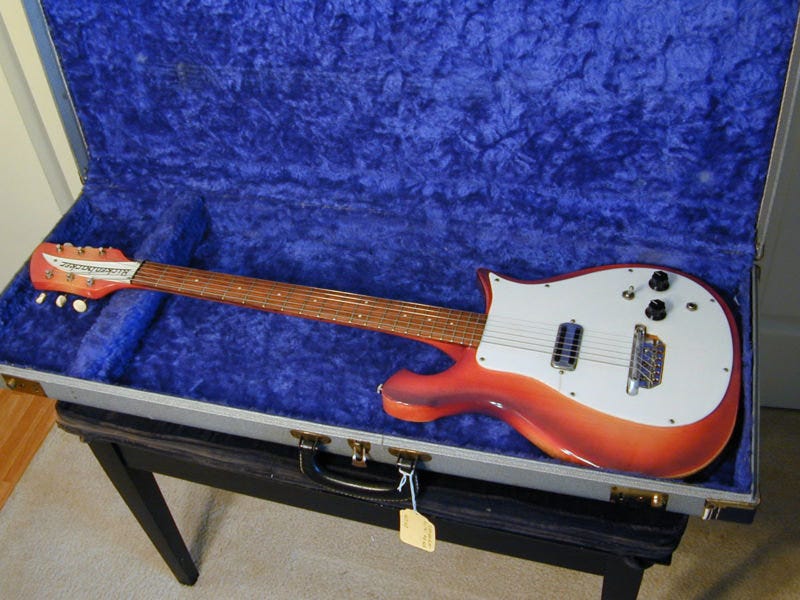
1963-1968: The Silver Case Era
By the middle of 1963 the transition to silver and blue crushed velvet was complete. Just like the elephant/red crushed velvet cases, the new cases (for the most part!) came in standard and deluxe versions—shown here for the 330-375 cases.

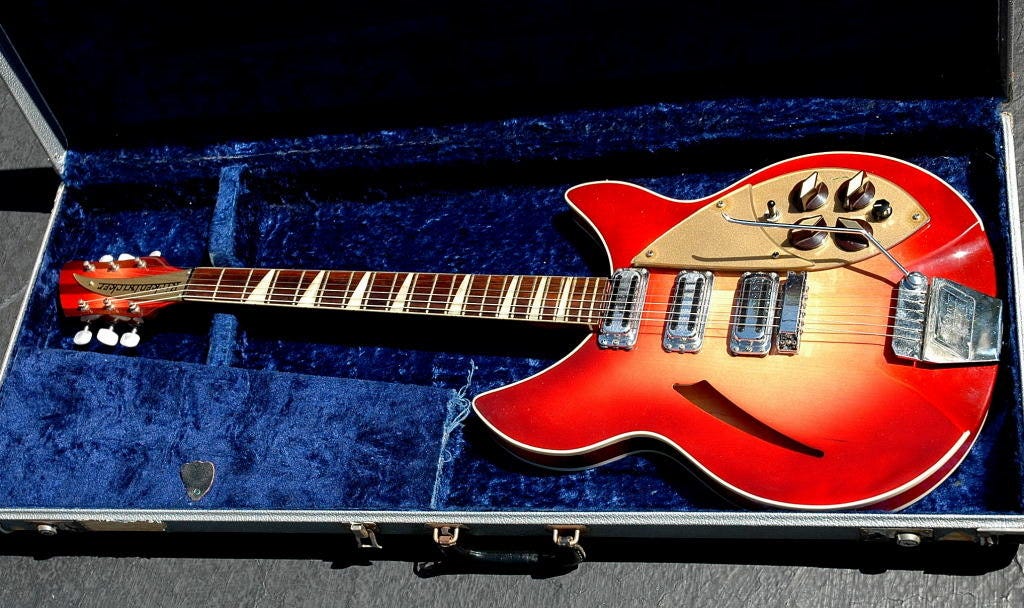
We’ve already seen the standard 400/600 case, but they also had a rarely selected deluxe case option.

Basses also got the new silver/blue crushed velvet case, and just like before in deluxe trim only.
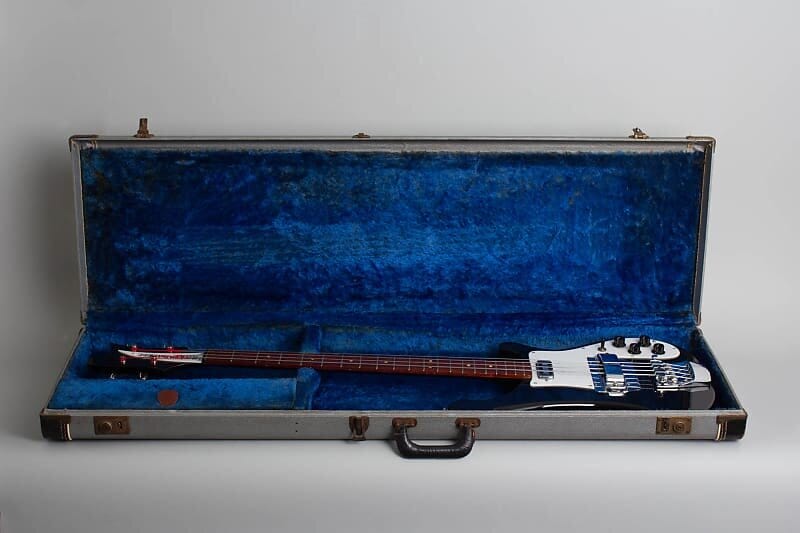
There was an exception to the silver Tolex/blue velvet rule though, as a new case design appeared in 1963 for the private label ES-16 and ES-17: a standard brown Rexine case with red interior.

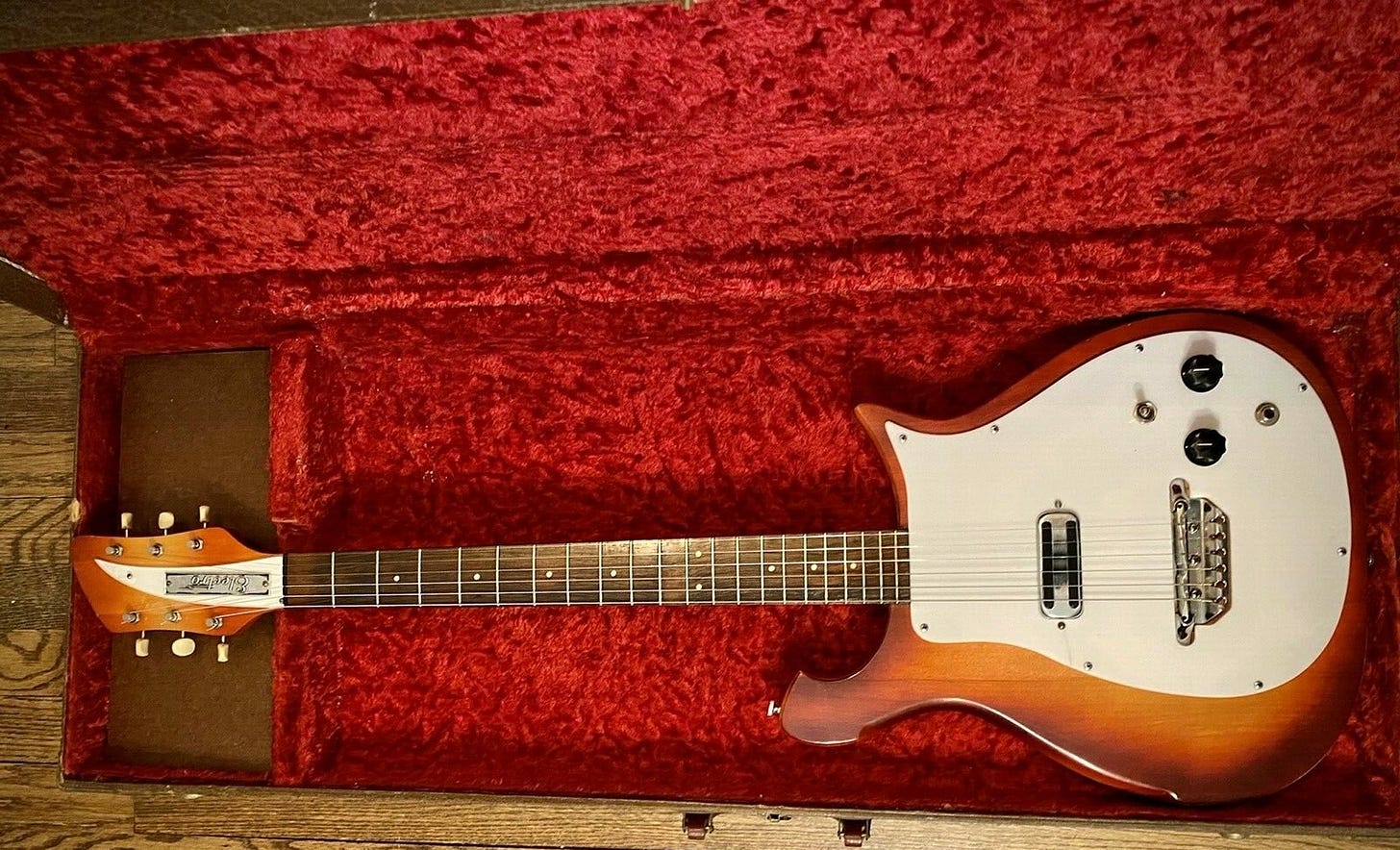

The short scale 900 and 1000 would also use the brown/red case, but the 950 would get a standard silver/blue crushed velvet case.

1964 production was largely consumed by guitars ordered by UK distributor Rose Morris. Rose Morris selected/created five guitar models and one bass for import, and selected standard cases for the 1993, 1995, 1996, and 1997 models, and deluxe cases for the 1998 and 1999 bass. At their request, these guitars had a Rickenbacker nameplate attached to the case—and in true thrifty Rickenbacker fashion these were the same nameplates that were being used on steel guitars.

So the 1993 and 1997 used the standard 330-375 case with a nameplate, the 1995 used the standard 400/600 case with a nameplate, the 1996 used the 950 deluxe case with a nameplate, the 1998 used a deluxe 330-375 case with a nameplate, and the 1999 got the deluxe 4000 series case with a nameplate.
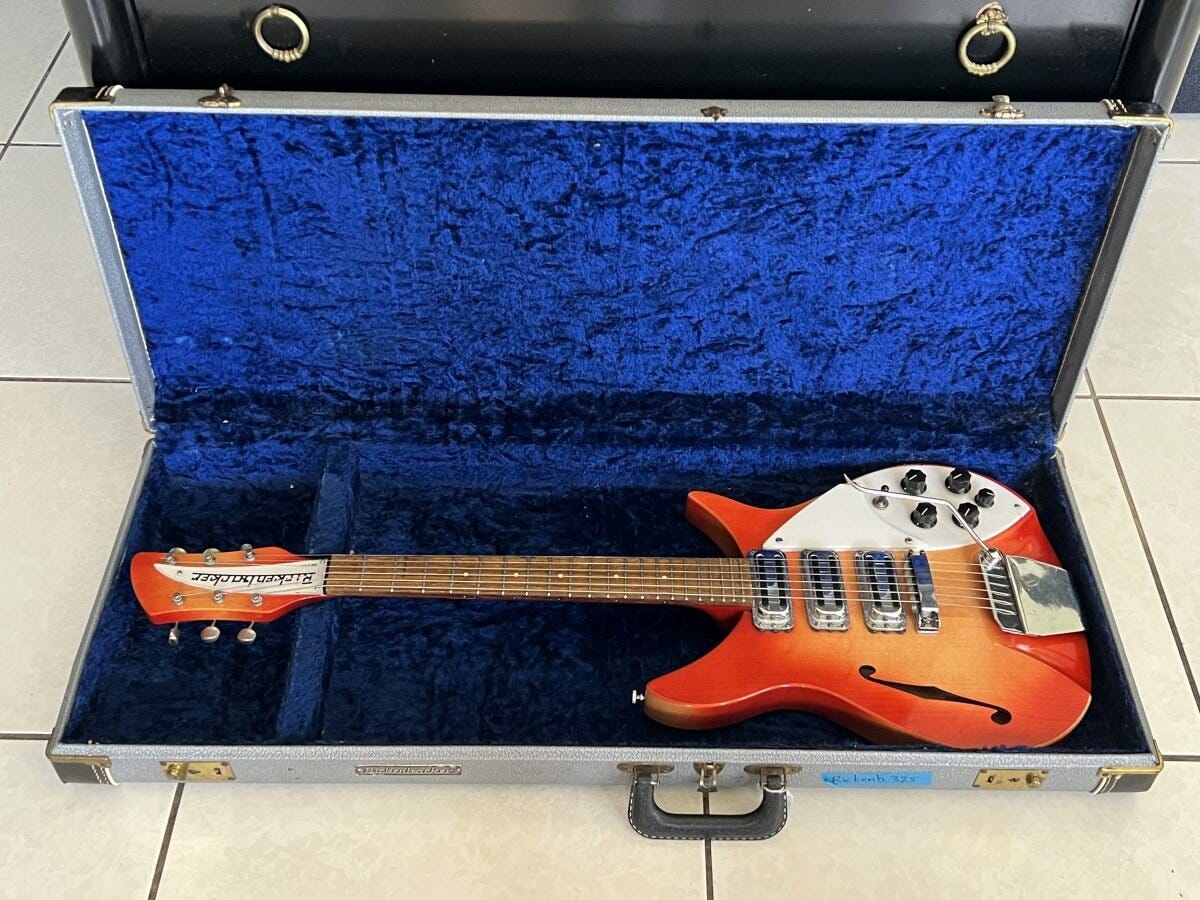


The only other change of note in 1964 was that the interiors of the brown Rexine cases would change from red crushed velvet to blue crushed velvet. This brown Rexine/blue case would be used on the private label guitars until their discontinuation—and beyond!
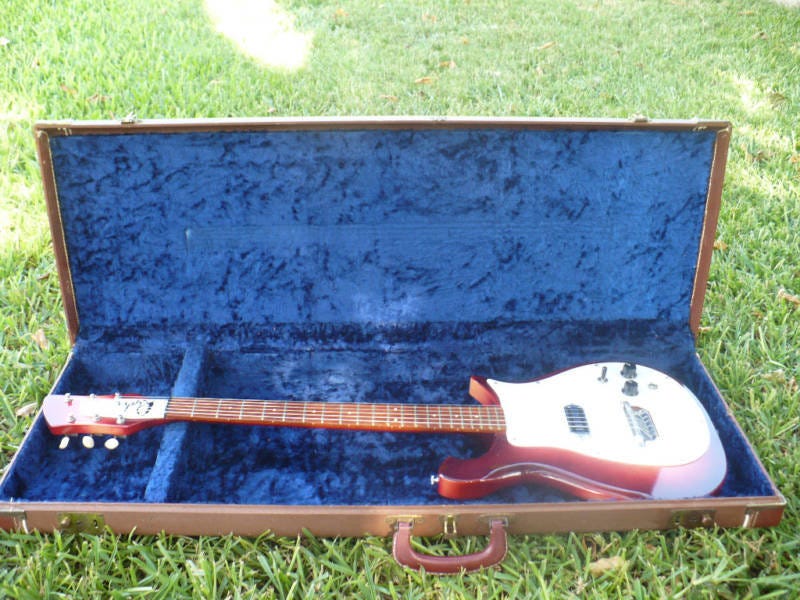
1965 brought only one new case: the much-bigger-than-the-4001 4005 required its own case, and it got it. Just like the 4000/4001 bass it came in “deluxe” form only.
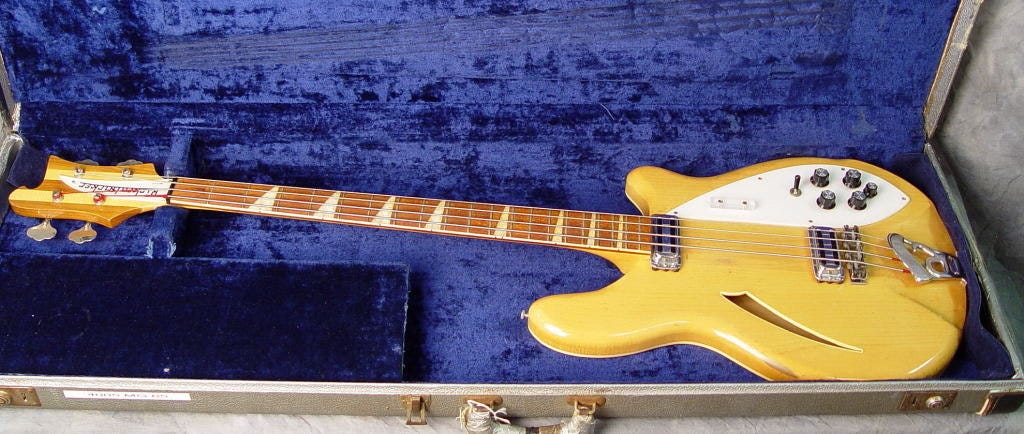
Well, only one OFFICIAL new case. Here’s a neat detail Collin Whitley shared with me. In February of 1965, a number of Rose Morris guitars shipped to Australia featured a RED crushed velvet interior!


1967 saw the reintroduction of the F-body line, and with them came a new large standard case in silver and blue:

Also new for 1967 was the 6000 Bantar, whose deluxe silver/blue case was the first to feature form-fit padding (if only at the bottom) since Rickenbacker’s very first “Spanish guitar” case for the Combo 600/800. It would also be, along with the F-body case, one of the last new silver/blue crushed velvet cases.
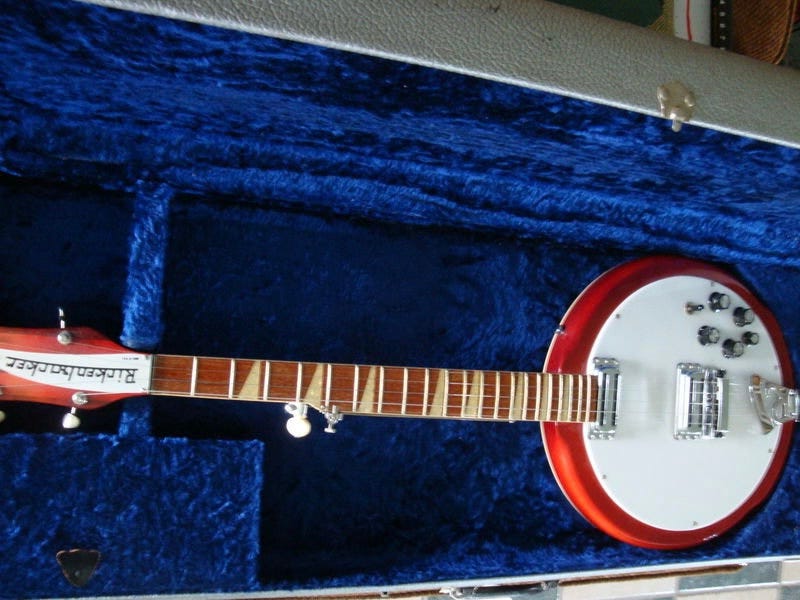
What? Yup. It’s true. The vintage era was coming to an end. Why? Well, in 1968 Rickenbacker sales started slowing down. Way down. And then in 1969 they fell off a cliff. All was not well in Santa Ana.
1968-1973: The Velveteen Era
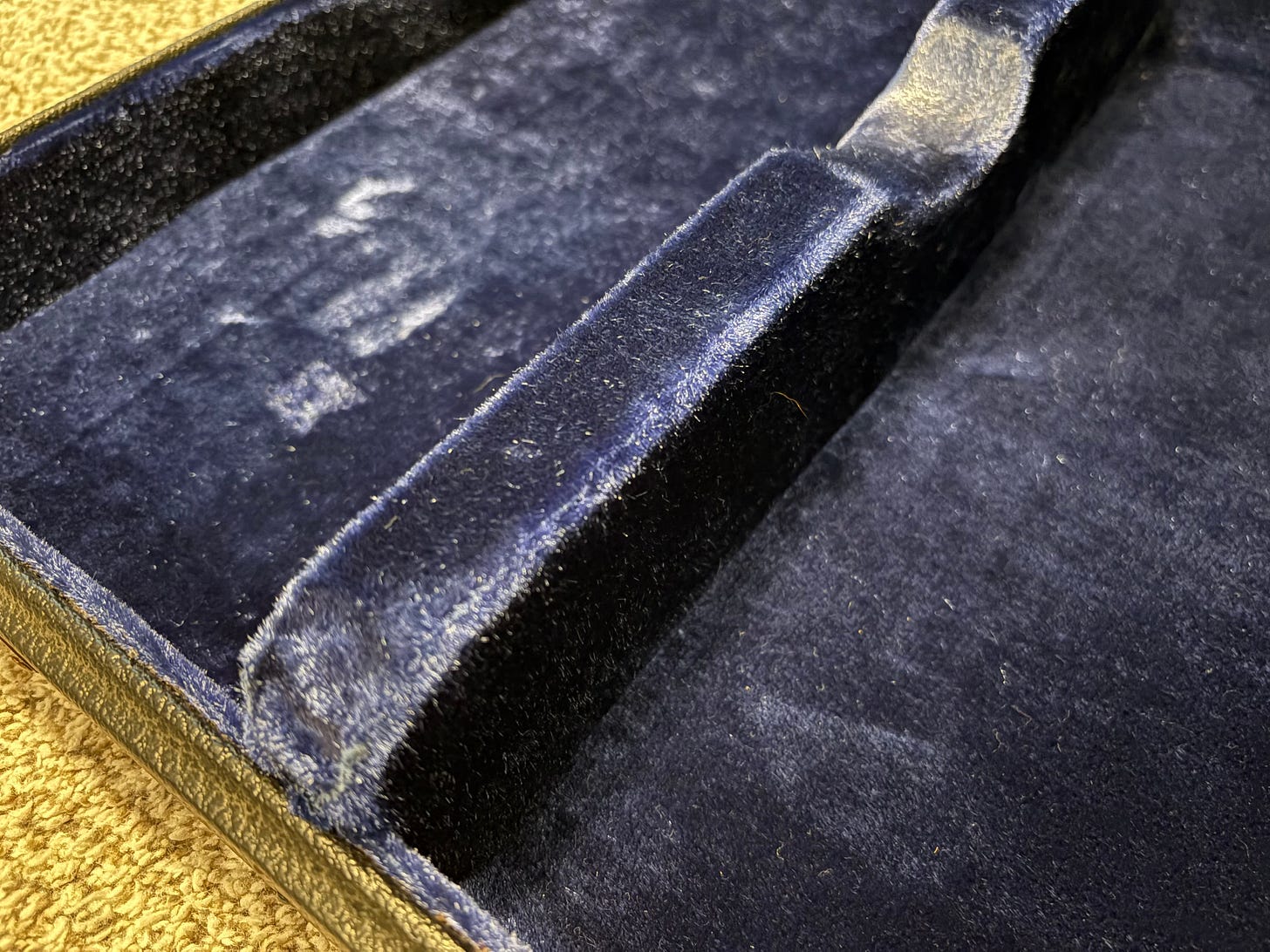
When it came time to reorder 4001 cases in early 1968, the new ones looked a little bit different. The silver Tolex was gone, replaced by black. The blue crushed velvet was gone, replaced by velveteen. A new era in cases had begun.

Why the change? Seems pretty obvious to me. Sales were in the crapper. Money was not rolling in. Employees were being let go. Black Tolex is about half the price of silver Tolex. Velveteen is a lot cheaper than crushed velvet. Seems like a logical explanation, no?
That said, silver Tolex WAS discontinued at some point—John Hall says he had to convince General Tire to reintroduce it for the vintage reissue cases. Could it be that discontinuation caused the change to black? Or did the change to black drive down silver demand enough to cause the discontinuation? We’ll likely never know—but I like my theory!
Now, there is no clean transition timeline. Starting in mid/late 1968 as they ran out of a particular silver case they reordered in black. Some cases it happened quick…some it took a little longer. And remember—they were NOT selling a lot of guitars at this time. And it looks like they had a LOT of some specific silver cases on hand or already on order. I have seen silver cases that I’m pretty sure are original as late as 1972! Add to that the fact that lots of guitars lose their original case somewhere along the way and a detailed timeline is just impossible.
So for 1968-1971, if it’s one of the old silver/blue crushed velvet cases or one of the new black/blue velveteen cases…it’s probably original? So let’s talk about those new black/blue velveteen cases…and a few transitional oddballs!
The first guitars to “launch” with a black/blue velveteen case from new were the 6005 and 6006 Banjoline twins, which got a standard case in the new format upon their introduction in mid 1968. Given their short lifespan, this would be their only case.

By 1971 things had mostly settled down, so let’s have a look at the 1971 price list to see what cases theoretically existed. I say theoretically because…c’mon. This is Rickenbacker. Of COURSE there are zombies and vaporware on there!

390 case? Vaporware. 380-385 Series case? Vaporware. 381-331 Series case? Ok, this is a real thing. Let’s talk about it!
The 381 was prototyped in 1968 and went into production in early 1969. As the body was a little bit deeper than the 330/360, it got its own case. And when I say it got its own case, I mean it got its OWN case! Construction was normal Rickenbacker deluxe case, but check out the red velveteen!
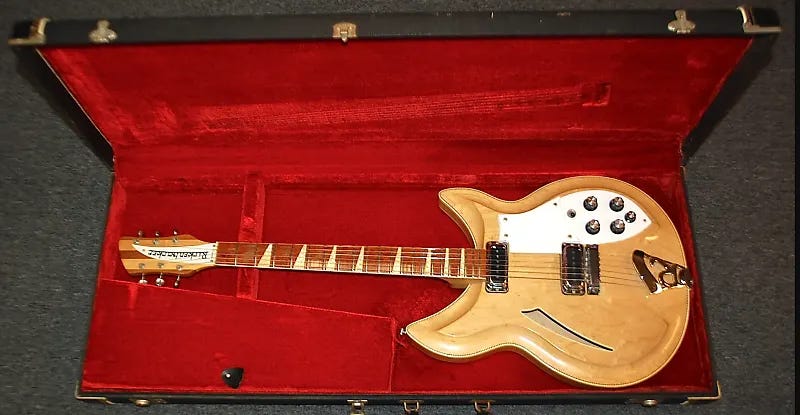
As one of the first “new” black cases, was Rickenbacker experimenting with interior colors? Did they get a good deal on the red? Who knows! But for most of its short original production run, this is the way it came.
In late 1970 a new guitar was introduced that also required the thicker case—the 331 Lightshow. The first few of these utilized the existing black/red velveteen case:

But when those ran out, the next batch was…different.
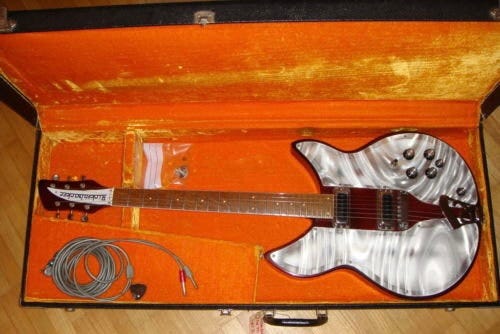
There were also “normal” black/blue velveteen cases over the 331’s relatively short (1970-1972) run.

The short scale 315-325 series saw very limited production during this era, but the few we have indicate that around 1970 they got a standard black/blue velveteen case.
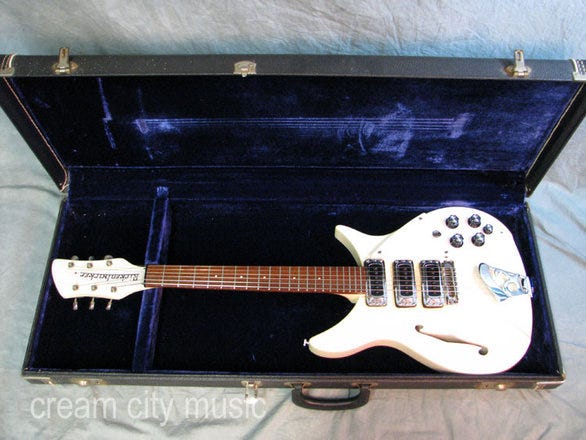
Next on the price list was 360F-375F F-bodied “deluxe contoured” case. Vaporware case (factory cases were not contoured) for a zombie guitar—none produced since 1969.
But now we hit some more real cases! 330-375 deluxe case. Black Tolex, blue velveteen interior, single neck brace between 1st and 2nd fret, with trapezoidal storage compartment. First appearance early 1971:

You’ve already seen some strange cases from this era, but here is probably the strangest one! In late Q3/early Q4 of 1973 we got a batch of 330-370 deluxe cases with a burgundy crushed velvet interior.

Next up is the 330-375 standard case. Black Tolex, blue velveteen interior, single neck brace between the nut and first fret. First appearance in mid-1970:

Of course, there would be a few brief interludes along the way. From late 1971/early 1972 we got a batch of black/orange velveteen standard cases.

And then in late 1973/early 1974 a batch of black/red velveteen standard cases.

For the solidbody guitars, we have four cases listed: deluxe/standard for the 600-850 guitars, and deluxe/standard for the 425-460 cases. In practice, however, I believe there were only two cases for all 400/600 guitars, both of them standard.
The first, which appeared in mid 1968, was brown with blue velveteen. These appear to have been used primarily for the 420/ES-17, but I’ve also seen a handful of 450s from this era with brown cases.
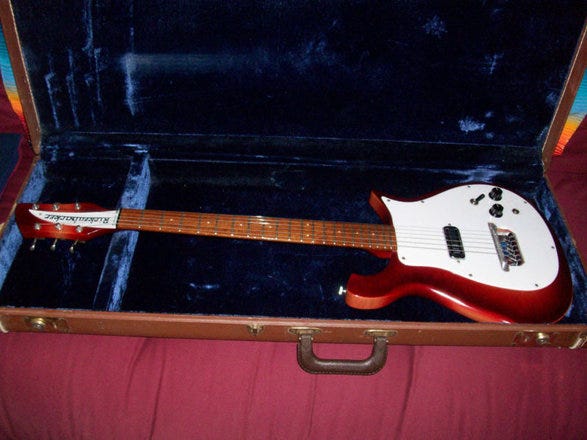
In late 1971 a batch of brown cases appear to have been produced with orange velveteen interiors.
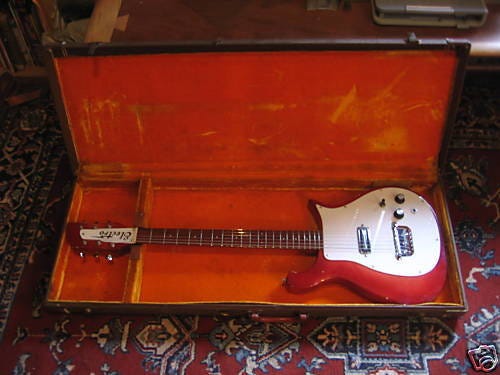
450/460s and 620s got a standard black case with blue velveteen interior, as did the 420 after 1972 when the brown case appears to have been dropped.

A case is listed for the short scale 900 guitars, but the handful I can find from this era appear to have leftover brown/blue crushed velvet cases.
The 3000/3001 basses listed here didn’t actually get made, so neither did the cases.
As we’ve already noted, the 4001 was one of the first guitars to get the new black/blue velveteen cases, with the first examples showing up around April of 1968.
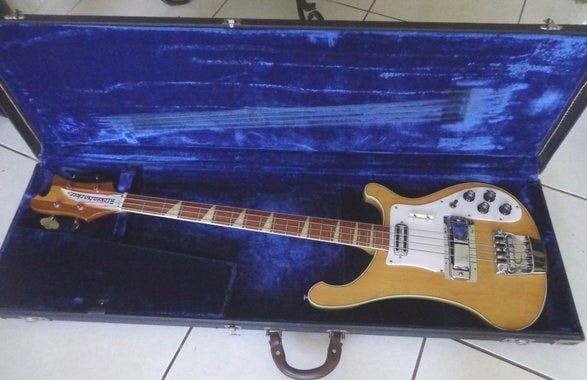
Although not called out as such, the only case offered was deluxe. Now, as you look at guitars from this era you’ll find a lot of them with “Fender orange” cases. Given the variety of colors we’ve already seen and the fact that Victoria Luggage made cases for both companies, does that mean some got made for Rickenbacker owith Fender’s fabric?
Well, here’s the thing. A Fender case is just slightly longer than a Rickenbacker case—a Rickenbacker will fit inside a Fender case, but a Fender will NOT fit inside a Rickenbacker case. So if the butt of your guitar is up against the case end and you have room above the top of the headstock…it’s not original.

And of all of the 4001s I’ve seen in an orange case…none of those cases fit correctly. So no, I do not believe there are any orange velvet Rickenbacker cases. But because this era was weird, it DOES appear that there was a batch of cases used from mid/late 1973 with red velveteen interiors.
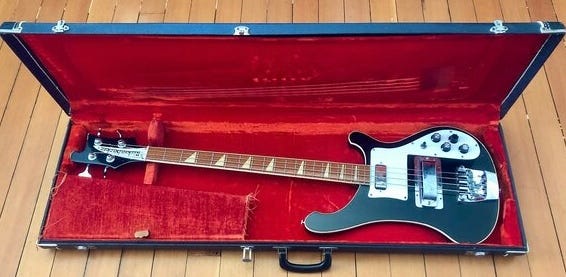
A slightly different black/blue velveteen case—with a smaller storage compartment and a form-fit bottom—appeared in mid 1973 and would appear alongside the older version.

And finally from that 1971 price list we have the 4005 case, which debuted in deluxe black/blue velveteen format in mid 1968.
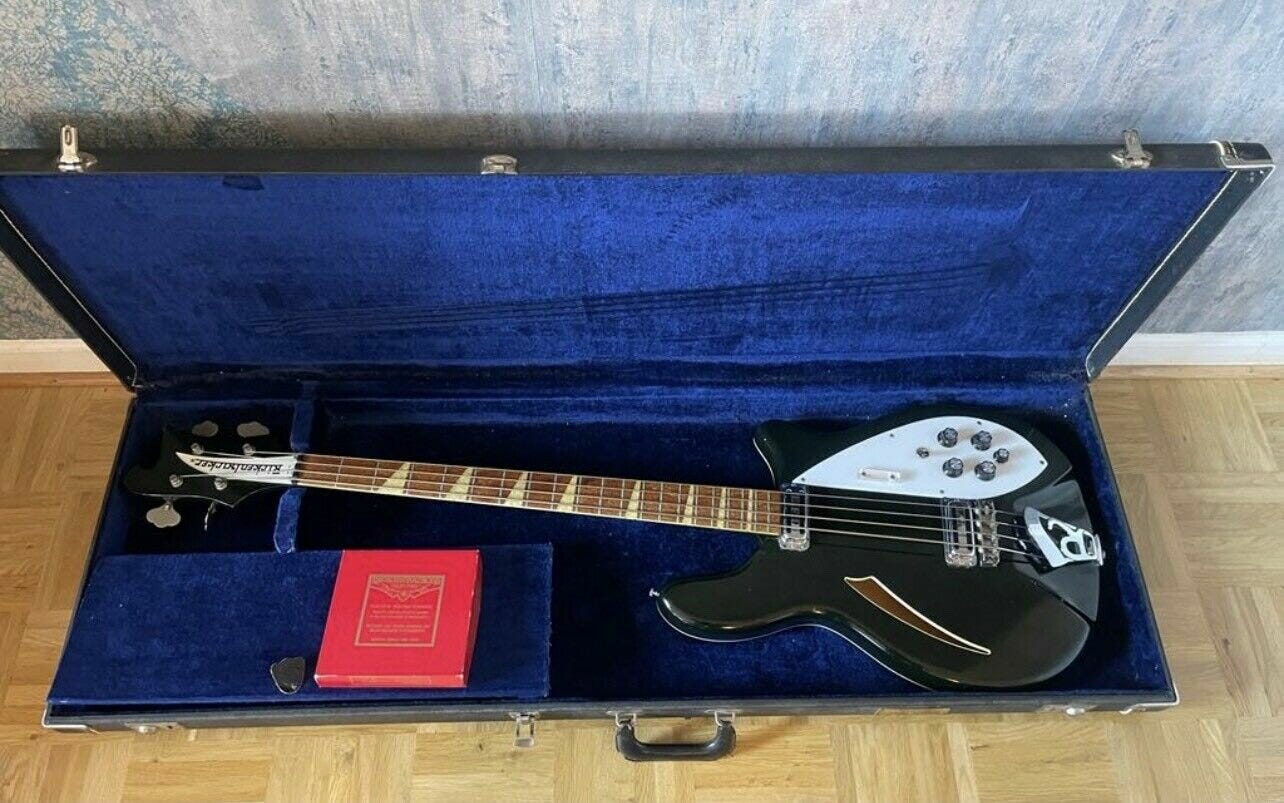
The 480 launched in mid 1972 with only a deluxe case. This same case would be used for the 481 when it launched in 1974. This would be the last new case to launch before the world turned upside down.
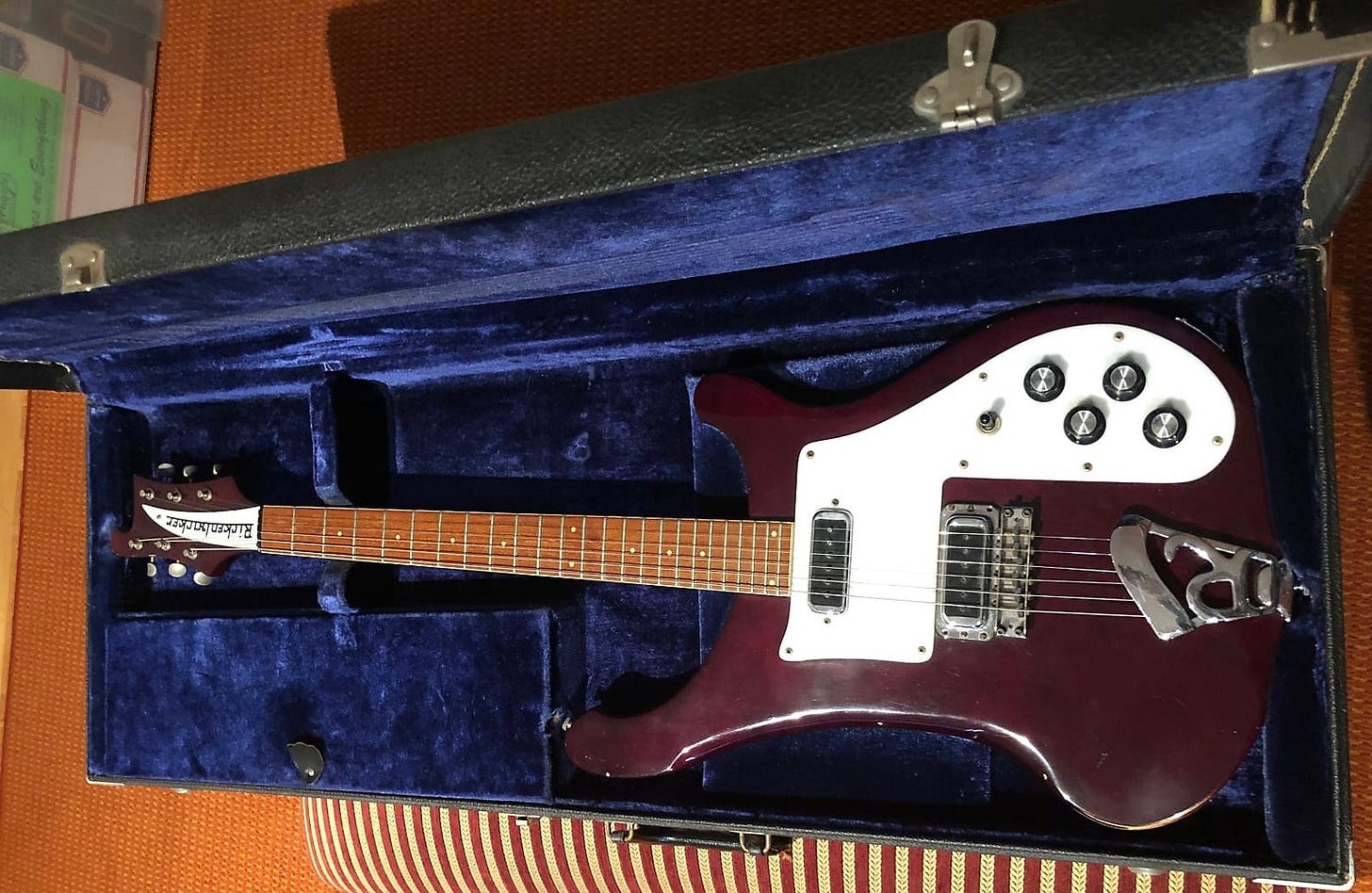
1974-1976: A Complete Mess
So way back at the beginning of this piece we talked about the Victoria Luggage Company. I won’t say they were the only case provider up until now—we know that “some” cases were made by the DeCuir Sample Case Company, for example—but Victoria was the primary provider by a huge margin. But in 1974 leadership changed at Victoria, and the business began to suffer. Rickenbacker needed other, more reliable suppliers.
DeCuir was an established player and gradually stepped into the primary supplier role. Geib Cases, another established player, also picked up some slack. And finally, G&G Cases—today’s supplier of vintage cases—was formed by former Victoria employees in 1976 and quickly grew their share of the business. Victoria Luggage was out of business by 1979.
All that is to say the mid 1970s is kinda all over the place case wise. In general, it is fair to say that this era saw the beginnings of the transtion from blue velveteen to blue wooly plush, but it happened case by case, on very different timelines. We would also see slight differences within the same model due to multiple manufacturers providing cases for the same model. The easiest thing to do is to just kinda show all the varieties you’ll find in this era, case by case. So let’s start with the 1974 price list and go from there.

The 480/481’s first new case—still only available as deluxe—appeared in mid-1974. It differed from the original in that the velveteen was replaced with a short pile wooly blue plush material and it was form fit at the bottom. This case would appear alongside the older velveteen interior case through early 1976 when the velveteen case seems to have finally disappeared.

320/325s from the early to mid 1970s are rare, and most have the older standard black/blue velveteen case—there was no deluxe case offered during this era. But around early 1976 they finally got a new standard black/blue plush case—with a form fit bottom like the 480/481 case.
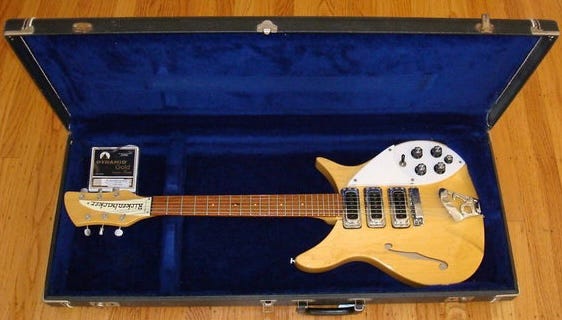
The 330-375 cases—both the standard and deluxe—appear to have been one of the last cases manufactured by Victoria to the “old” black/blue velveteen spec. I ido not believe they changed from that spec during this period—although a deluxe black/blue plush case may have appeared towards the very end of 1976.
The 400/600 guitars got a new deluxe black/blue plush case with “halfway form-fit” bottom in late 1976.

A standard 400/600 case in black/blue plush appeared at roughly the same time.
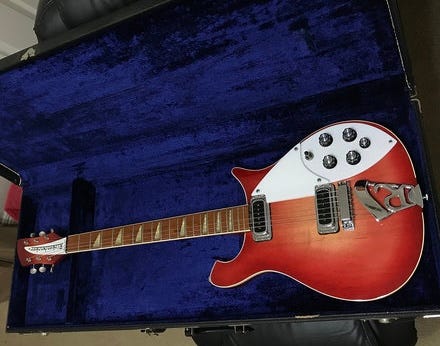
The 4000/4001 would not see a transition to plush during this era, with both versions of the deluxe velveteen case appearing through the end of 1976.
The 4005 would go on hiatus after mid 1975. All guitars manufactured up to that point featured the old deluxe velveteen case.
We did see a number of new guitars launch during this brief era. The doubleneck 362 debuted in 1974–early in this era—and as such the first cases came in the deluxe black/blue velveteen with form-fit bottom flavor:
The 4080 doubleneck got something very similar when it debuted a year later in 1975. Note the support post between the necks to provide some crush protection!
The 430 launched in 1975 with a standard black/blue velveteen case.

The short-scale 3000 bass, got an old-style deluxe black/blue velveteen case with a form-fit bottom for its two year (1975-1976) production run.

The 3000’s larger brother, the 3001, launched in 1975 with a similar, but longer case.

By late 1976, however, it had transitioned to a deluxe black/blue plush case with form-fit bottom.
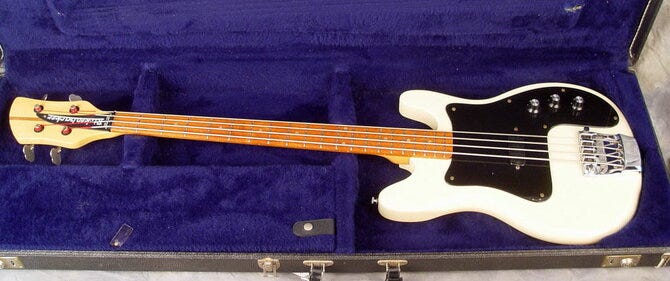
This case would be used until 3001 production ended in 1979.
1977-1988 The Form-Fit Plush Era
As the chaos of the last few years died down, the company began standardizing around a common template. Many folks believe that some of the company’s best cases were produced during this period. Still “classic” looking with their black Tolex exteriors, most of these cases featured the best internal support/protection to date with their well padded form-fit interiors. To many—myself included—they were the complete package.
That said, just like the preceding period there were a number of different cases for each model during this era. The period began with the same basic suppliers, although Victoria Luggage would be completely out of business by the end of 1978. By the end of this era, however, only G&G would be left standing as the other legacy manufacturers like DeCuir and Geib would also meet Victoria’s fate.
We would also see the end of the standard case during this era—the 1980 price list would be the last to offer both standard and deluxe cases for most models. From 1981 onward all cases would have deluxe features—and with no need to to differentiate, the “deluxe” term itself would be dropped from the 1985 price list.
Let’s go to the 1977 price list to kick our discussion of this era off.
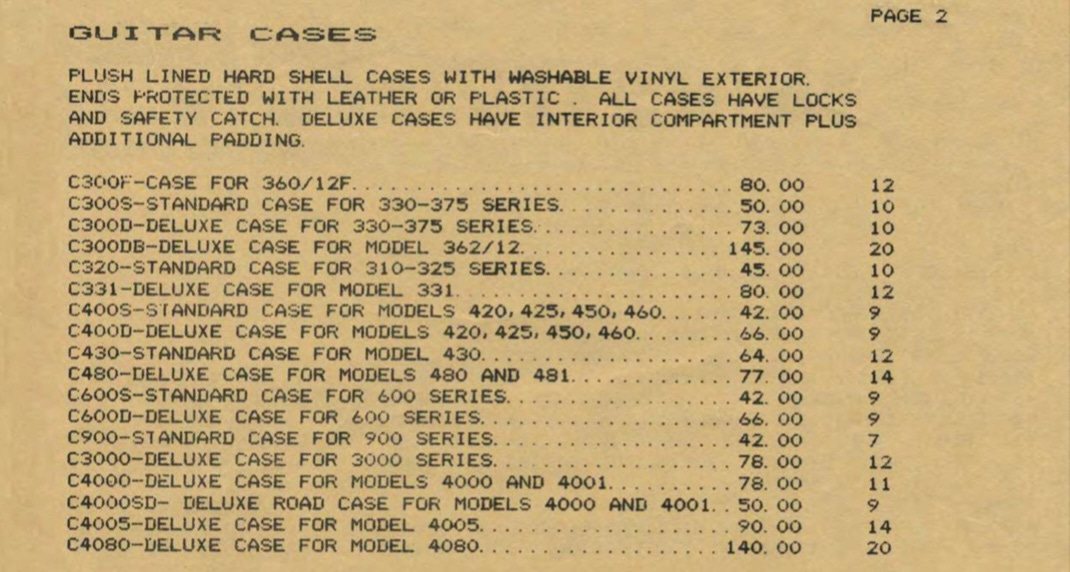
There was in fact a standard black/blue plush case for the 330-370 models, although I have not seen any after late 1978. It appears to have debuted in early 1977. This case is exceedingly rare.
In early 1977 a deluxe black/blue plush case was introduced for the 330-370 guitars. This first iteration featured form-fit padding for the bottom of the guitar.

The first form-fit 330-370 deluxe case would appear in early 1979. It featured two neck supports at roughly the nut and twelfth fret.

In mid-1980 a modified version of this case appeared with a partial shelf between the two neck support bars.

These two cases would appear side by side until mid 1981 when a new version debuted that would eliminate the upper neck support bar and extend the support shelf to offset.

The same case but with black plush would debut at the same time.
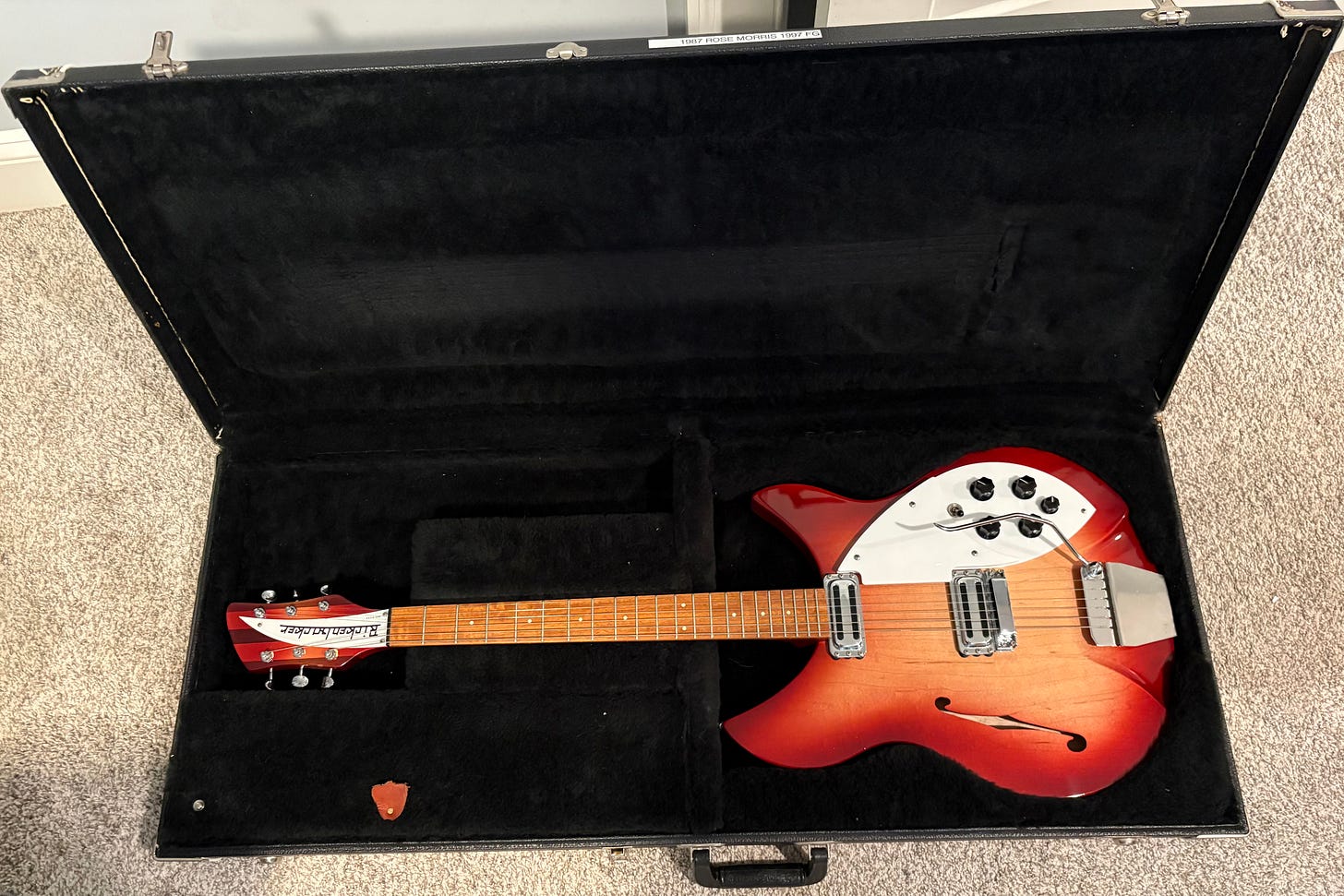
The two would be used side by side until 1989–although there appear to be very few blue cases from 1985-1986.
In early 1978 the 320’s standard black/blue plush case would be replaced by a deluxe version, although the price list would continue to only list a standard case until 1981. This version of the deluxe case would feature form-fit bottom padding.

This case would not last long, being replaced in mid 1979 with a fully form-fit blue plush case.
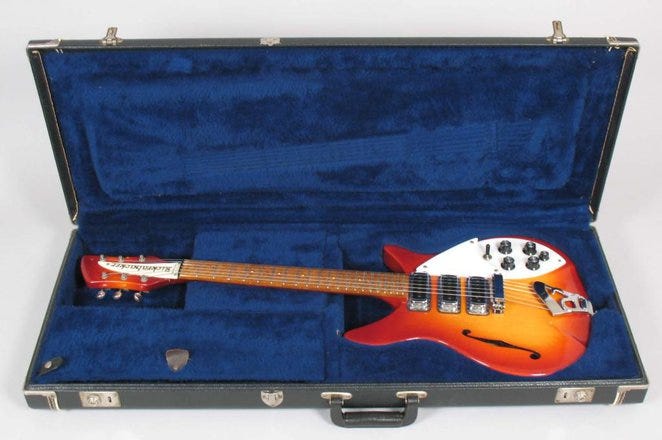
A black plush version would appear alongside the blue in 1983 and be used interchangeably through 1988.

This case would be used for the first several “reissue” 325s—the B-Series, 325V63, and 325V59.
The 400 and 600 series were in dire straits sales-wise, with the 420 being discontinued in 1982 and the 450 in 1985. The 620 also wasn’t doing well, but the cover of “Damn The Torpedoes” gave it a new lease on life in 1979. With that came a new deluxe, form-fit blue plush case.

This case would be replaced in mid-1980 to one with a solid neck support shelf.

This case would be joined by a black plush version in 1982. Both cases would appear side by side until 1989 although, yet again, there appear to be very few blue cases from 1985-1986.

In late 1977 the deluxe 480/481 case, which already had a form-fit bottom, got form-fit sides as well.
Mid 1978 saw a similar case appear, but with full neck support shelf between the nut and 11th fret. Both cases would appear side by side until the 480/481 ended production in 1982.
Moving on to the bass side of the house, around June/July of 1977 two deluxe black/blue plush cases appeared for the 4000/4001/4002 cases to replace the old velveteen cases. One had padding for the top of the lower bout of the guitar:
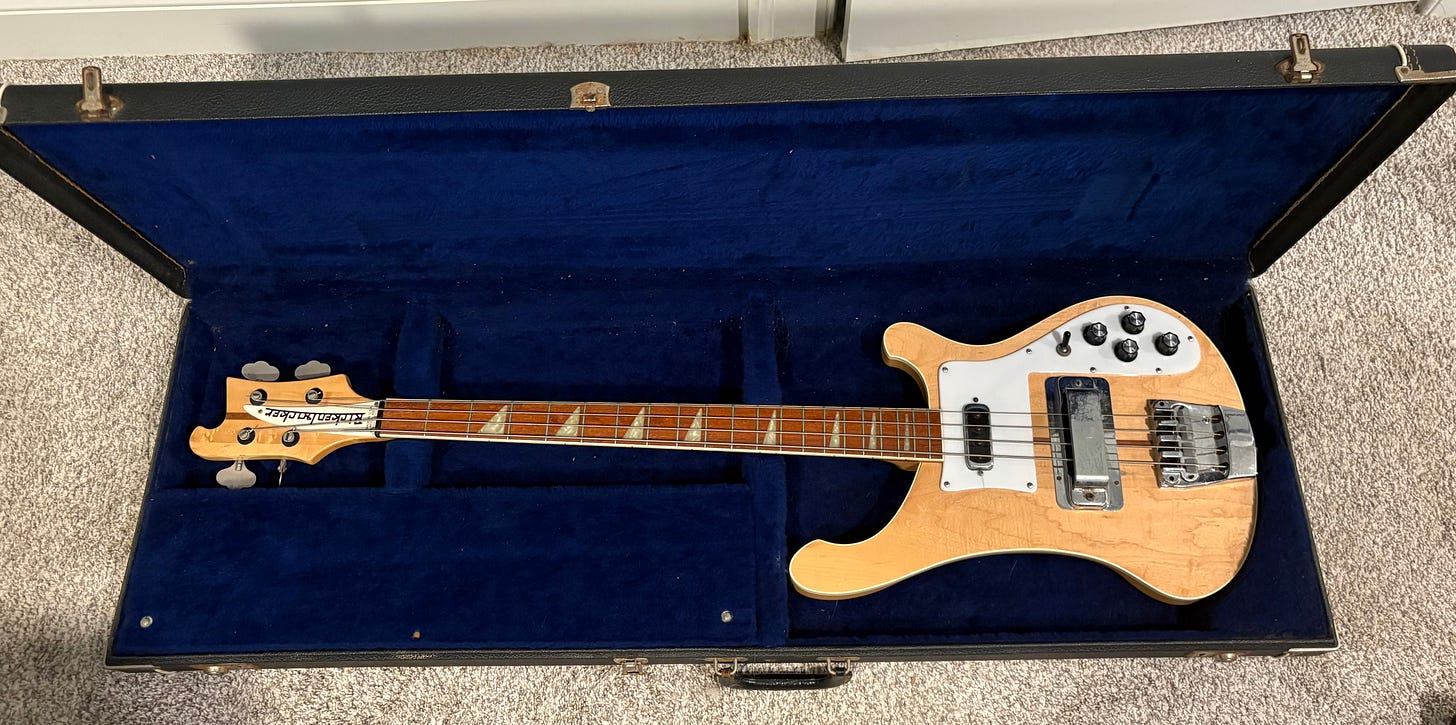
The other had padding for the entire bottom of the guitar.

These two cases would be used side by side until July of 1979 when they were replaced by a deluxe black/blue plush form-fit case.
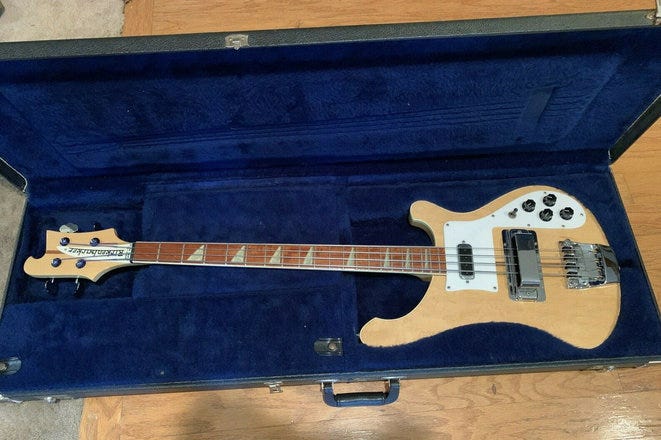
This case would be joined by a black plush version in mid 1980. The two cases would then appear side by side until the form-fit cases were replaced in 1989.

You may have noticed a “Deluxe Road Case for Models 4000 and 4001” on that 1977 price list above. The price of $50 was a typo, as the 1978 price list was corrected to $150–almost double the price of the “regular” deluxe case. It gained a “Super” in front of the “Deluxe” in 1978 and remained on the price list until 1984. And I have no idea what it is or if it even existed. Any information would be most welcome!
The 4005 returned to production in 1979 after a four year break. The very first examples featured leftover 1968-1975 deluxe velveteen cases, but this would be quickly replaced by a deluxe black/blue plush form-fit case. This would be the only case used through the end of production in 1982.

The 4080 doubleneck transitioned to a form-fit blue plush case in late 1977, losing the center support post between the necks.

In the mid to late 1980s as production wound down we also saw similar cases with black plush interiors.
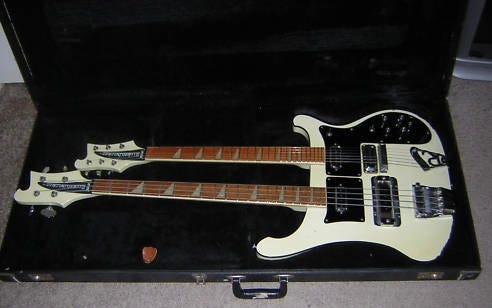
The doubleneck 362 was one of the last guitars with a velveteen case, not transitioning to a form-fit blue plush case until late 1980.

This era saw some new guitars launch as well. When the small body 350 Liverpool launched in 1983, despite being overall about an inch longer than the cresting wave guitars, the body contours were close enough that it utilized the existing 400/600 case. Yes, the price lists say it has its own…it doesn’t. And since it was the same case as the 400/600, you will find it with blue plush…
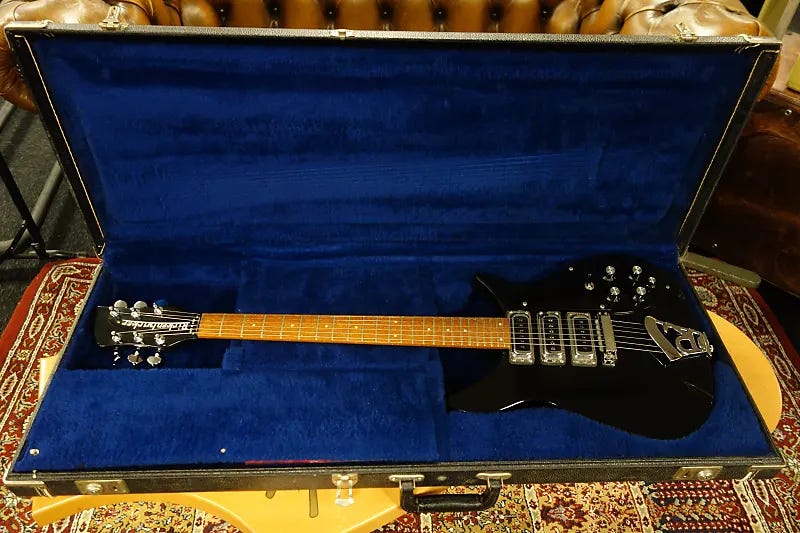
…and black plush.

Both cases would be used interchangeably until early 1989. And just in case you doubt that it’s the same case, remember that the 350 is about an inch longer that the 620. Here’s how the headstocks of each guitar fit in the case. Note where the nut is in relation to the support shelf and where the top of the headstock lands:


The 200 series of guitars and basses launched in 1984. The 200 series guitars would also use the same form-fit case as the 400/600/350.
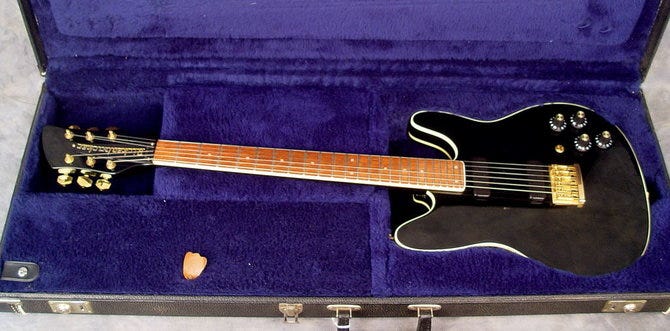
The 2000 basses got their own form-fit black/blue plush case.
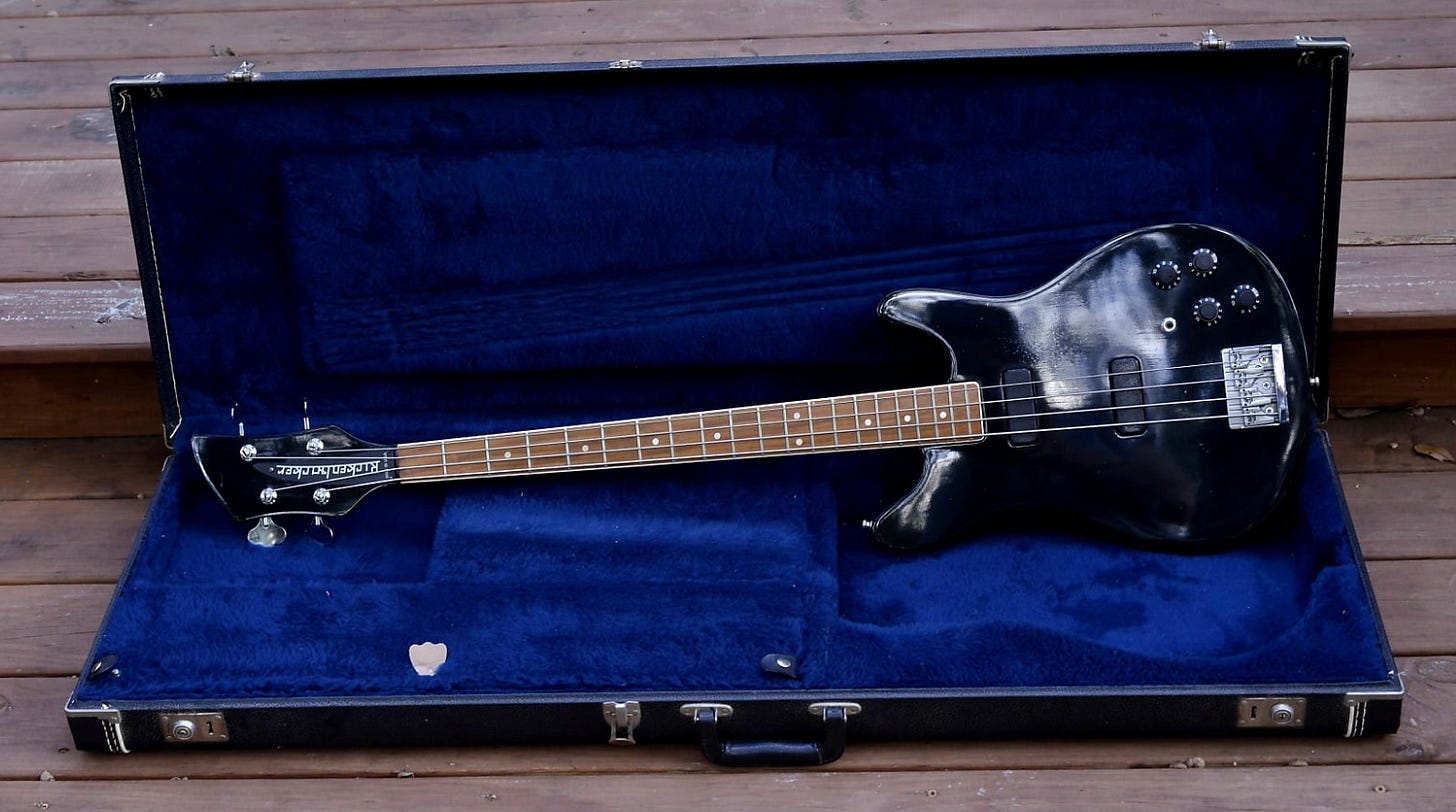
This case would be used until the 200 series was discontinued in 1993–making it one of the last form-fit cases in the line (spoiler alert!).
And finally, the 381V69 models would launch in late 1987 and would introduce the last of the form-fit cases, in blue plush only (at the time). Change was in the air!
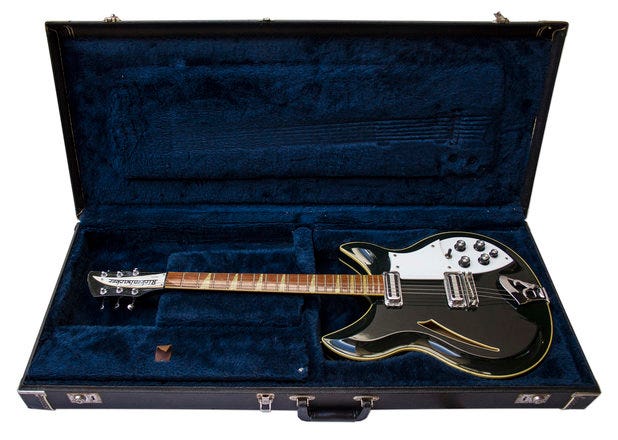
1989-1994: The Vintage Reissue Era
We’ll talk about the Vintage Reissue cases in a minute, but first we have to talk about 1989, because that sets us up for the Vintage Reissue cases.
In 1989, all the form-fit cases lost their “form-fit.” Take the 330-370 case as an example. Here’s a February, 1989 360 in the familiar deluxe black/blue plush form-fit case.

Jump ahead a couple months, though, and our form-fit padding is gone. The neck support shelf is shorter. And the case itself is a bit shorter, with the guitar now held at more of a diagonal.
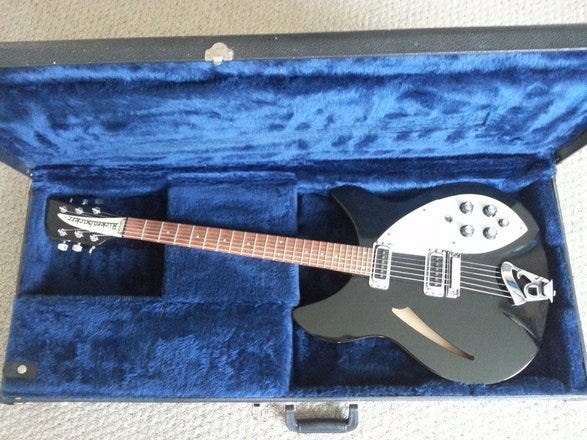
The 310-325 case also lost its form-fit padding in early 1989.

When the Susanna Hoffs 350SH Signature Limited Edition rolled off the line in February of 1989, it came with a new black/black plush case for the small bodied guitar without the form-fit padding. Like the 330-370 case, it had a large neck support shelf and a more diagonal orientation.
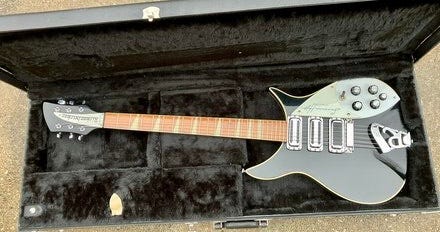
The black plush case would be replaced by a different case in blue plush later in the year. This case would be used for the 350 Liverpool as well starting midyear.
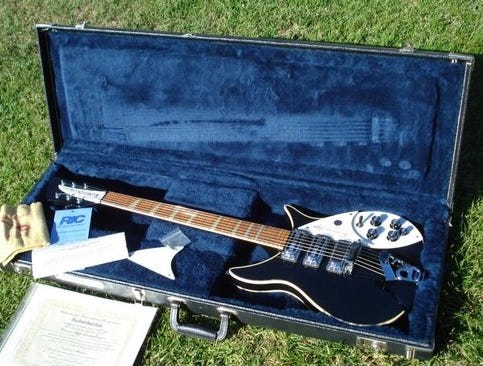
Unlike with the form-fit cases, the 350 and 600 Series guitars WOULD get different cases this time. You can easily spot the difference by looking at the neck support shelf—on the 350 case it runs from about the third to the twelfth fret, and on the 600 case it runs from the first to the twelfth. 200/350/600 guitars. The 200 Series guitars would also use the 350 case.

The new 4000 series case appeared mid-1989.
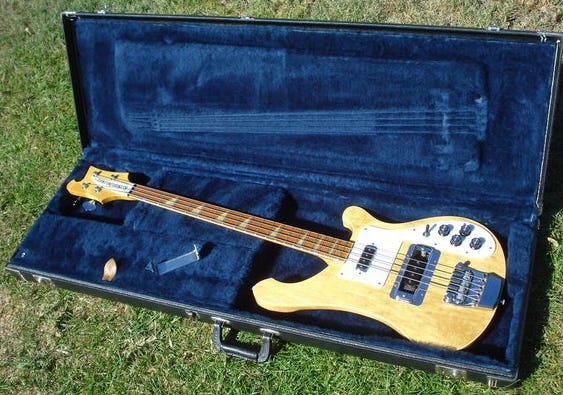
And the last case to lose its form-fitting padding was the 600 case in early 1990. Again, note the longer neck support shelf as compared to the 350 case.

Notice anything unusual about that case? Between the latches, maybe? We’ll get to that in a minute, I promise.
While the 381 would not get a non form-fit black case, in late 1989/early 1990 there was at least one batch of the old style form-fit cases with a black plush interior.

Okay, let’s move on from that outlier. The stage was now set. And when the Tom Petty 660/12TP Signature Limited Edition began production in March, 1990, it came with something special: the first new silver Tolex case in over twenty years.

This would be the first of six deluxe “vintage reissue” cases to appear over the next two years. Manufactured by G&G Cases—Victoria Luggage’s spiritual successor—these cases mimicked the vintage silver Tolex/blue crushed velvet cases from the 1960s. John Hall apparently had to twist some arms at GenCorp (General Tire’s successor) to make it possible as silver Tolex had been discontinued for quite some time.

Now while these cases were clearly inspired by the 1960s originals, they were not exact replicas. First, the interior support was different, with all six cases getting much more substantive neck support than the originals, which tended to only have a cross bar at the nut. And more obviously, all reissue cases got a riveted “Rickenbacker” nameplate by the latches—a feature that had previously only appeared on early Rose Morris guitars.
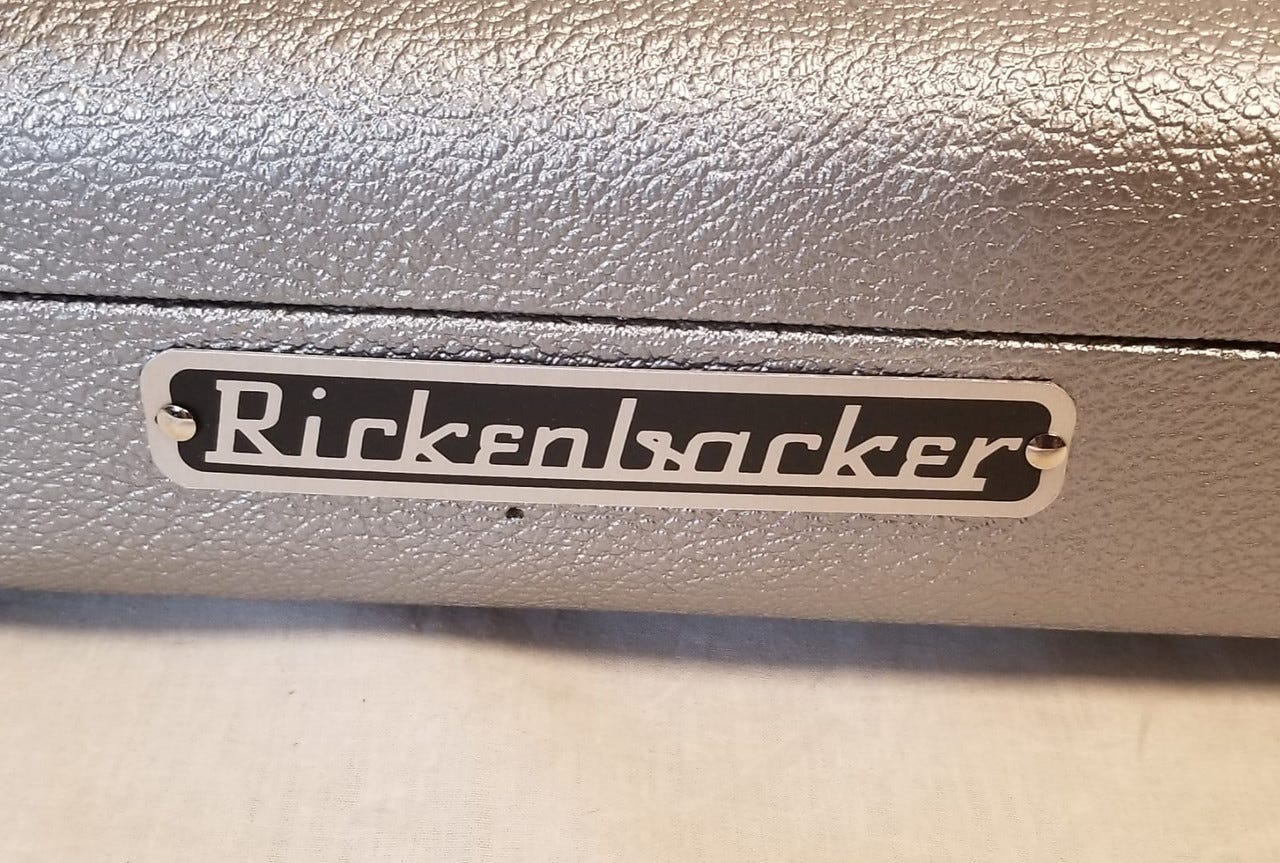
Ironically, the first model to get the “vintage reissue” case was neither vintage nor a reissue! But the 660/12TP was certainly “vintage-inspired”, so we’ll let it slide.
And about that nameplate…while all the vintage reissue cases featured one, you WILL find some black/blue plush cases from late 1990-first half of 1991 thusly equipped. We saw a 600 Series example above, and you can also find 330/360 and 320 cases from this period with the nameplate. Accident? Changed their minds? We don’t know. Just know that from this brief period they do exist.
Now you may look at this case and the ones that follow and say “hey, those look like a lot like the normal period cases we just looked at, but with silver Tolex instead of black and blue crushed velvet instead of blue plush.” You’d be correct. They 100% are. But they do look cooler!
The short scale case first appeared on the 325JL in May of 1990.

Oddly, the 325V63 and 325V59 would continue to use the old black/blue plush case until the end of 1992. That case would remain on the price list until 2006–they must have had a pile in the warehouse!
The Lennon 350 variants’ case came next, first appearing on the 355JL and 355/12JL models in May, 1990. After the JL models finished production in 1993 the 355JL and 355/12JL would have their signature pickguards stripped and be rechristened the 350V63 and 350/12V63 for the 1994 model year. Both guitars would get the deluxe silver “Vintage Reissue” case despite being neither vintage nor reissue models.
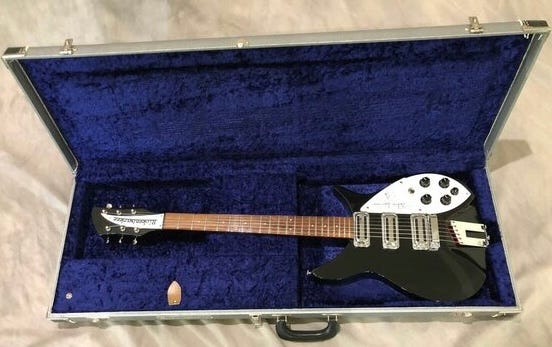
Note that the case used at launch is not the same as the the 660/12TP’s despite both guitars having roughly the same dimensions. You can easily spot the difference in two places: the 350 neck support shelf is shorter, and given that the case was originally designed for the 24-fret 350 Liverpool, it’s about an inch too long for the 21-fret 355JL.
However, around late 1990 the 350 models would transition to the same case as the 660/12TP, making the original version of the vintage reissue 350 case fairly rare.

The fourth vintage reissue case would appear on the 4001V63 in August.

The Chris Squire 4001CS Signature Limited Edition model would launch in April of 1991 with this case as well.
The 360V64 and 360/12V64 would keep their old black/blue plush cases quite a while, with their vintage reissue case not appearing until April, 1991.

The last vintage reissue case to appear was for the 381V69 and 381/12V69, debuting in late 1992/early 1993. Production would continue on the John Kay 381JK Signature Limited Series and Edition through 1995, but it would not get a silver case until the very last few were produced—presumably after all black/blue plush case stock had been depleted. Those would in fact be the last form-fit cases to leave the factory

So by early 1993 we had a complete cast of characters in place. We had a 350/600 case in both black and silver, a 330/360 case in both black and silver, a bass case in both black and silver, a 381 case in both black and silver, and a short scale case in silver only. So we started with six silver cases and ended with five.
But most of those cases had seen a slight tweak since their introductions. In mid 1991 the small body case had gotten a little bit shorter—moving the guitar to more of a diagonal—and seen the neck rest shrink slightly and and move from roughly the 3rd-12th frets to roughly the 2nd-8th frets. This first appeared on the black/blue plush cases mid-year.

The silver case would follow around December, 1991.

The silver version of the tweaked bass case started showing up around December 1991. The neck rest platform also moved and shrank slightly.
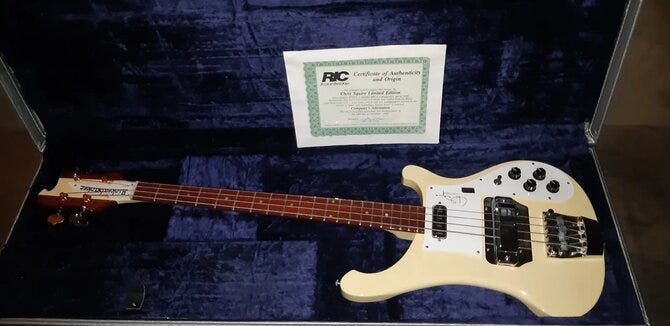
The black/blue plush version appeared around April of 1992.

The tweaked 330-370 black/blue plush case appeared in December, 1992, once again with a moved and smaller neck support platform.

The silver/blue crushed velvet version appeared around February, 1993.
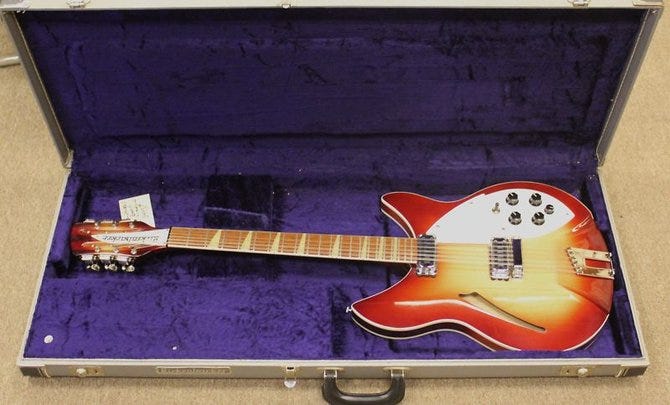
The silver short scale case saw a similar change around December of 1992 with the neck support—which had run from about the second to the eleventh frets—moved slightly and shrunkso that it now ran from around the nut to the fifth fret.
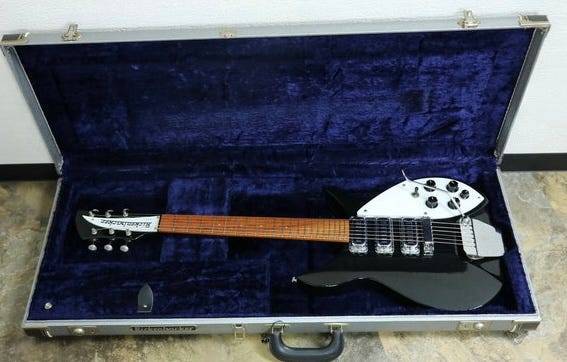
There no longer was an non-vintage short scale guitar in the line, so there was no black version of this case, although “leftovers” of the old black case were still available for order.
As the last of the silver cases to launch in late 1992, the Vintage Reissue 381 silver case launched with the smaller platform as compared to the existing black case. The black case would not be updated before it was dropped in late 1994—leaving the silver case as the only 381 case.
The 650 guitars launched in 1992. The price list says it has its own case. Kinda? It used the black/blue plush 620 case, but early examples took a “scoop” out of the headstock padding to allow the 1” longer 650 to fit.

That wouldn’t last long. By the end of the year they just kind of “made them fit” without the scoop.
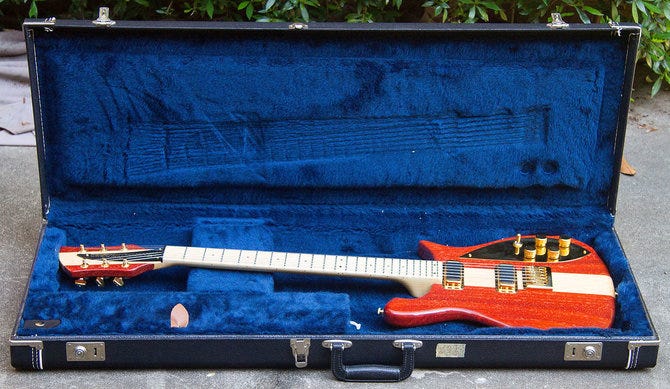
When the 4004 bass appeared in 1993 it utilized the 4003’s black/blue plush case.

The 650 and 4004 would be the last guitars to launch with a black Tolex case. Major changes were in the air!
1995-Present: The Modern Era
1995 brought what is probably the most dramatic change to Rickenbacker cases in the entire timeline: the introduction of the molded SKB case.
While there had been distinct standard and vintage reissue cases for some time, the differences had been largely cosmetic. The new molded case—which would be used for all “non reissue” models—was a completely different animal.

Manufactured by SKB, instead of Tolex-covered wood the shell of the new case was made of hard molded ABS plastic, with integrated molded “feet” on the back and a molded attachment point for a protective metal foot on the bottom. Each half of the case had a strengthening aluminum lip/edge that interlock upon closing.


Ironically, that protective foot would prove to be the most vulnerable part of the case as a hard strike there can crack the supporting plastic or even drive the foot through it.
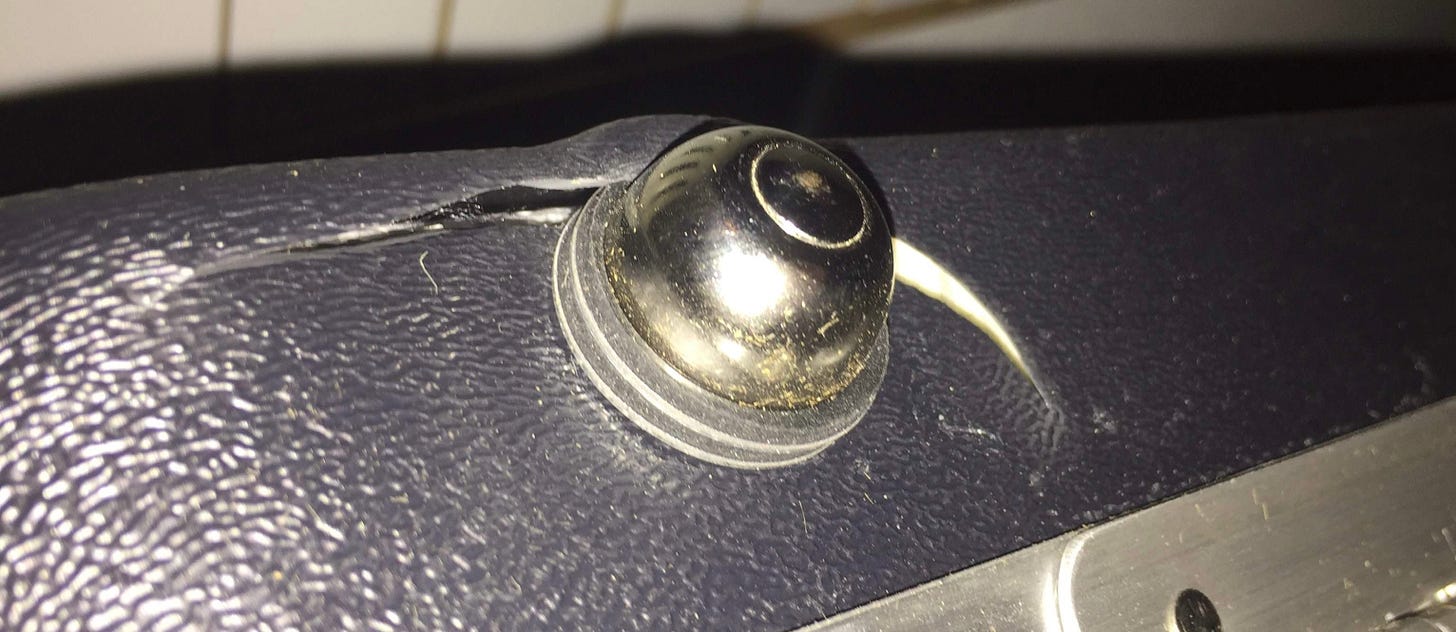
Apart from that weak point, the cases are very sturdy and protect their contents extremely well. The interior was molded styrofoam covered with a wooly blue plush material. The styrofoam lining in each case was form fit for the model(s) the case was designed for.
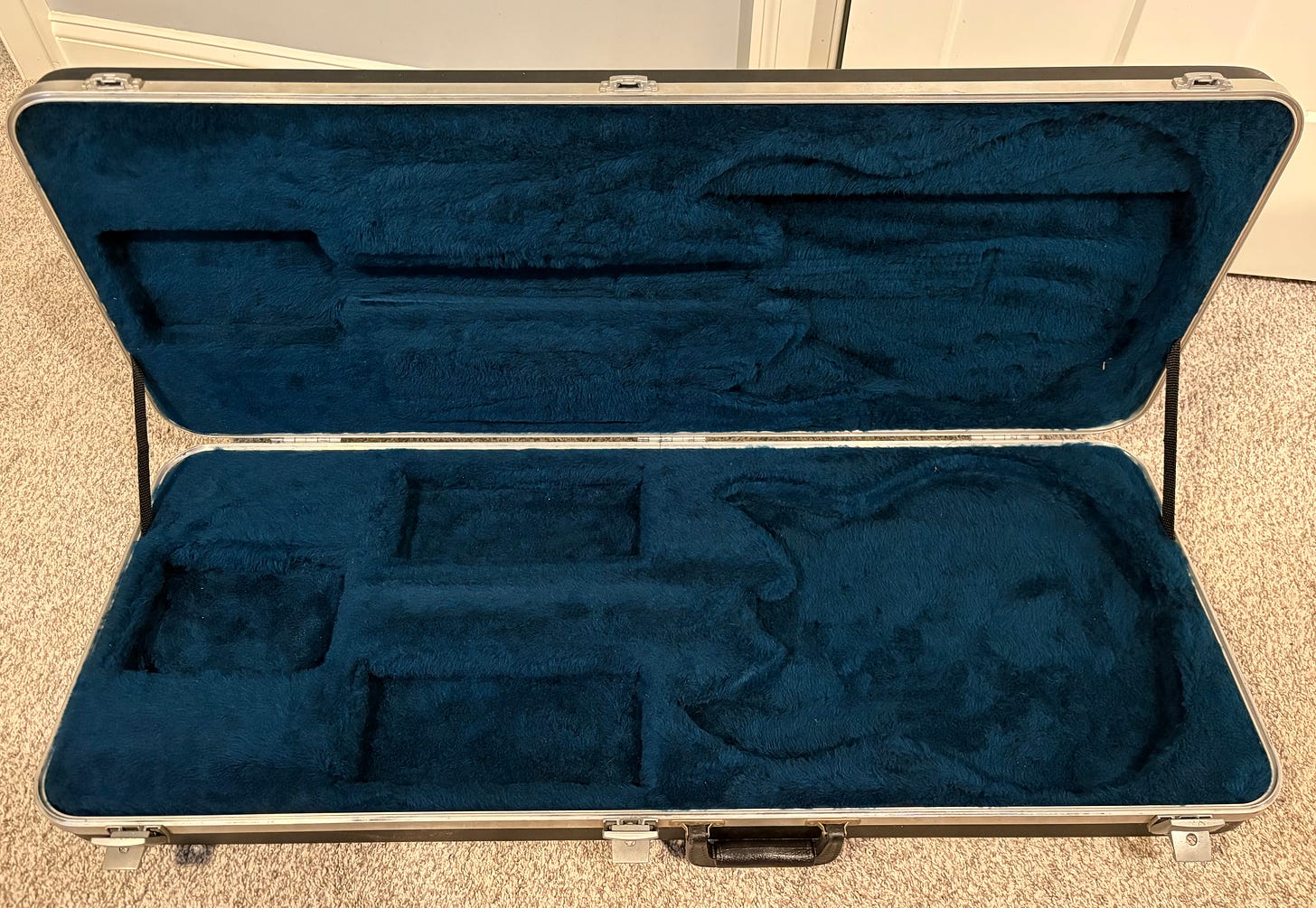
This molded case would be used for all non-vintage reissue models and came in four sizes. The smallest fit all small body guitars: 200-series, 350, and 600 series.

The smallest of the bunch, this case first appeared around March, 1995 and features a full form fit interior with full length neck support, one small inset storage compartment, and a plush wooly blue lining. While the storage compartment doesn’t have a closeable lid, note how there’s a molded “lid” on the other side that holds things in place when the case is closed. As noted above, the same case was used for the 24 fret 350 Liverpool…

…and the 610, 620, and 650 models.

Notice where the top of the headstock falls on the 610/12 above versus where it falls on the roughly 1” longer 650 in the same molded case below:

The second case fit full size 330, 360, and 380 models. It differed from the smaller case in having two storage compartments—one on each side of the neck.

The third case was a bass case, for both the 4003 and 4004. Like the small solidbody case, it had only one storage compartment.

So that’s three cases we’re all very familiar with. Let’s take a closer look at the standard cases on the 1995 price list:

We’re going to ignore the three acoustic cases at the bottom and talk about the other two cases we haven’t discussed yet. We have a short-scale case listed that’s just a carryover of the old black/blue plush case—there would not a molded short scale case—and then we have the mystery case. “Molded for all 381 models”.
I went in thinking this was vaporware. But sure enough, it exists.

I believe (but cannot confirm) that it is the same shell as the 330/360 case. So how does that work? It appears that more of the styrofoam support was removed—creating a deeper well to hold the thicker body. While it remained on the pricelist until 2001, it’s rare—I’ve only found a handful of examples in the wild.
So the line was set, right? Well, not exactly. Between 1996 and 1998 the crushed velvet interiors of the vintage reissue cases changed twice. So here’s where we need to talk a bit more about crushed velvet.
Crushed velvet is made by…crushing the pile of the fabric while wet to create a pattern. Depending on the length of the pile and how it is crushed the appearance can vary dramatically. “Original” silver/blue cases from the 1960s are often referred to as having “poodle” velvet because of its appearance.

The first version of the reissue cases was fairly close to the original.
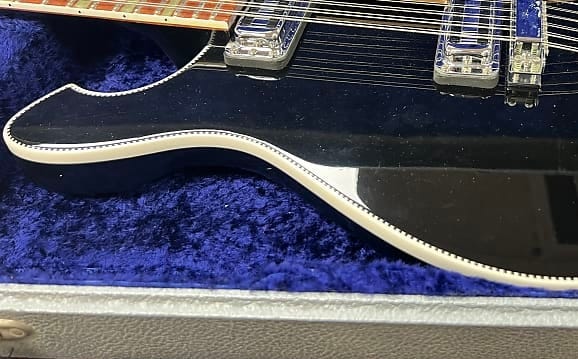
In mid 1996 the crushed velvet became noticeably “wrinkled” looking.
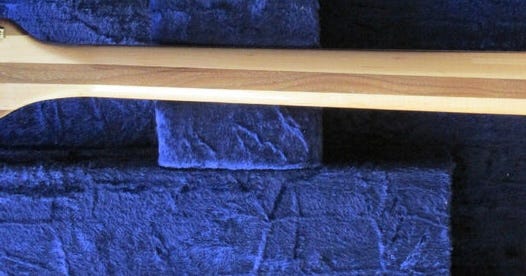
And then in early 1998 the “crush” became much more extreme, resulting in a very “marbled” and multi-colored appearance.
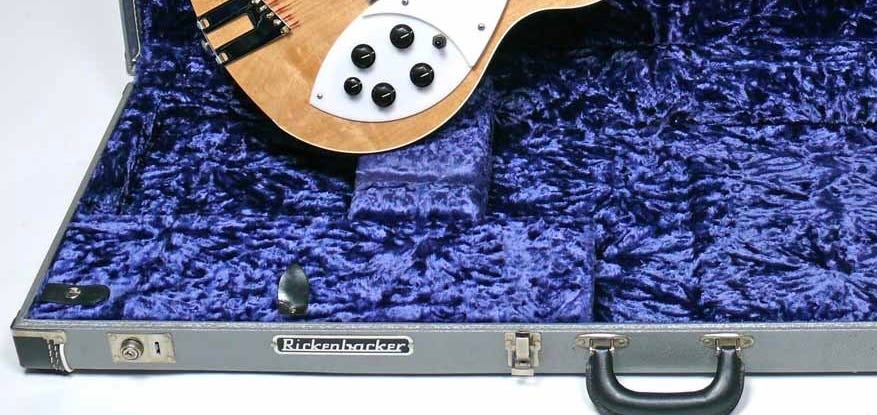
Apart from the crushed velvet, there were no other major changes to the cases so I’m not going to bother showing them all with the different velvets. Just know that the first change happened in mid 1996 and the second in early 1998. The vintage reissue cases have not seen any significant changes since.
That said, the vintage reissue cases have been used for special run guitars throughout this era. One such example is the 1999 425V63/450V63 run, which used the 350V63’s case.

Another such example was a 2009 run of Montezuma Brown 310s for the Japanese market, which used the 325C64’s case.

While I can’t list all such examples, a good rule of thumb is if there’s nothing “unique” about a guitar and it has a vintage reissue case, it’s probably not original.
When the 660/12TP was de-Tom Petty-fied and launched as the standard 660 and 660/12 in 1998, it came with the same vintage silver/blue case the 660/12TP shared with the 350V63.
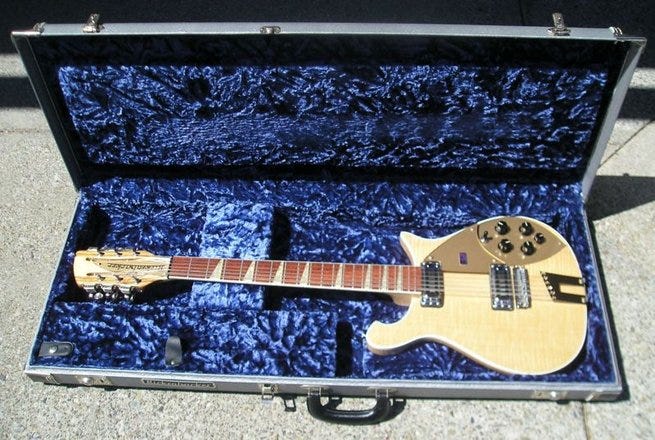
But in mid 2000 it would transition to the small body molded/blue plush case.

Moving back to the molded cases, their first change came in mid 2000 when the interior styrofoam molding pattern of the 4000-series case was revised, creating larger storage areas on either side of the neck.

The next change came in 2003 when the lining changed from wooly blue plush to wooly black plush. The interior layout would not change, only the color.
The bass and small body cases would appear first in May.


The 330/360 case would follow in August.

As near as I can tell, there have been no significant changes to the molded cases since.
As regards new guitars from this era, when the 1993 Plus launched in 2015 it would feature a molded black plush case like its “quasi-vintage” brother the 660, only it would utilize the large hollow body 330-370 case.

The 2021 90th Anniversary Models would bring two new vintage reissues cases. Well…one and a half. The 480XC took the existing silver/crushed blue velvet bass case—which fit the body perfectly—and modified the neck support block and added a padded block to fill the gap above the top of the headstock.
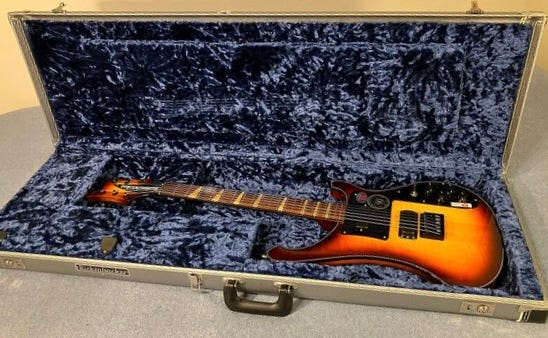
The 4005XC case WAS new given the guitar’s all-new dimensions. But here’s an interesting fact. Notice the padding at the top and bottom of the case, as well as along the bottom bout of the guitar.
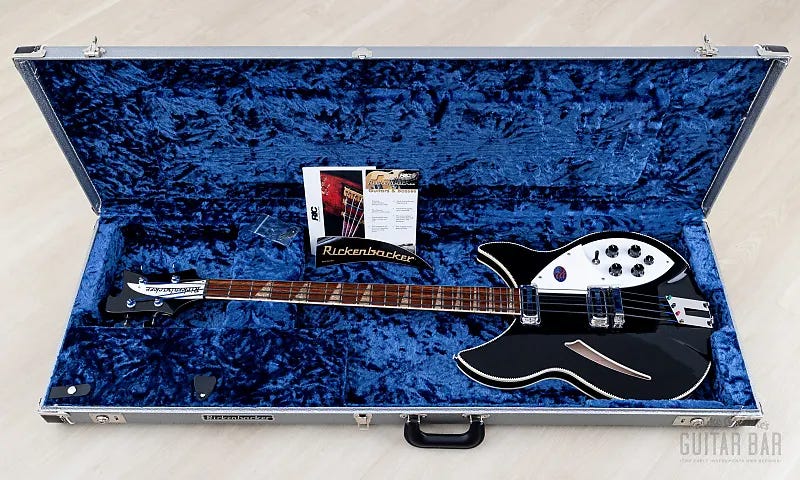
Why do that, right? A brand new case for a brand new guitar shouldn’t need that extra padding, right? Except…here’s the new for 2024 4005V with the same case, minus the top and bottom padding:

Looks like the 4005V was in the works for longer than we thought!
And that, I believe, is that. An as-complete-as-I-can-make-it timeline of original hard shell cases. What a freaking workout! But now you should be able to tell with a fairly high level of confidence if that guitar “with OHSC” actually has an “original era-correct, factory-supplied case” or not, and adjust your offer accordingly. If I got something wrong, put it in the comments and I’ll correct!
Want to learn more about…everything else? Check out the rickenbacker101 site map and see what’s already been covered! Have a suggestion about what we should tackle next? Drop it in the comments and we’ll add it to the queue.


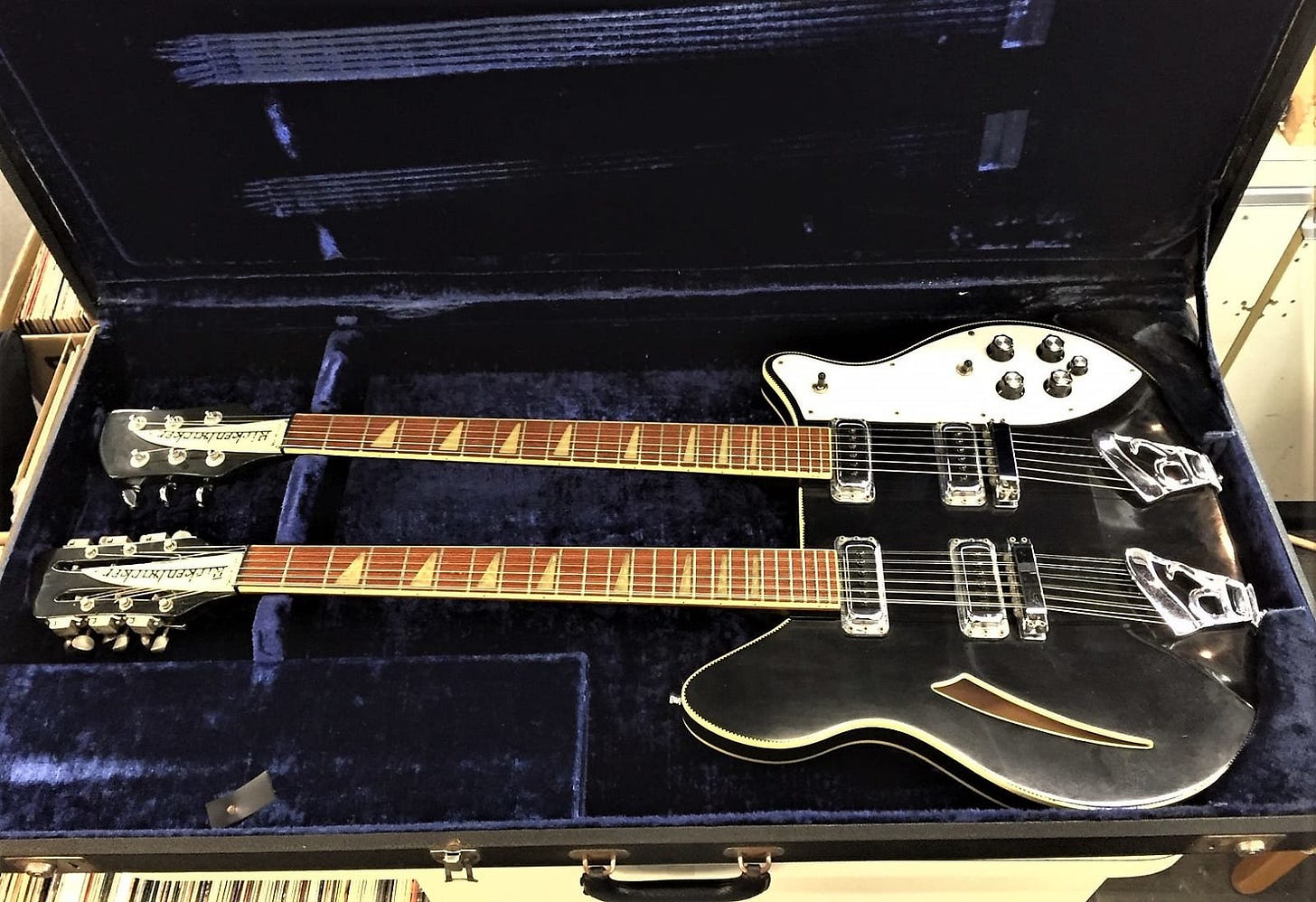
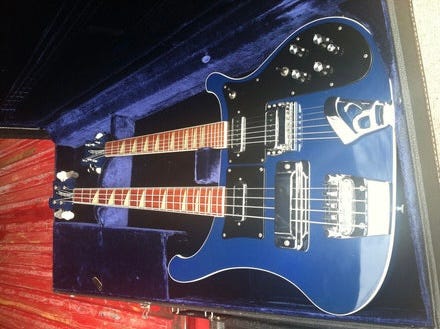
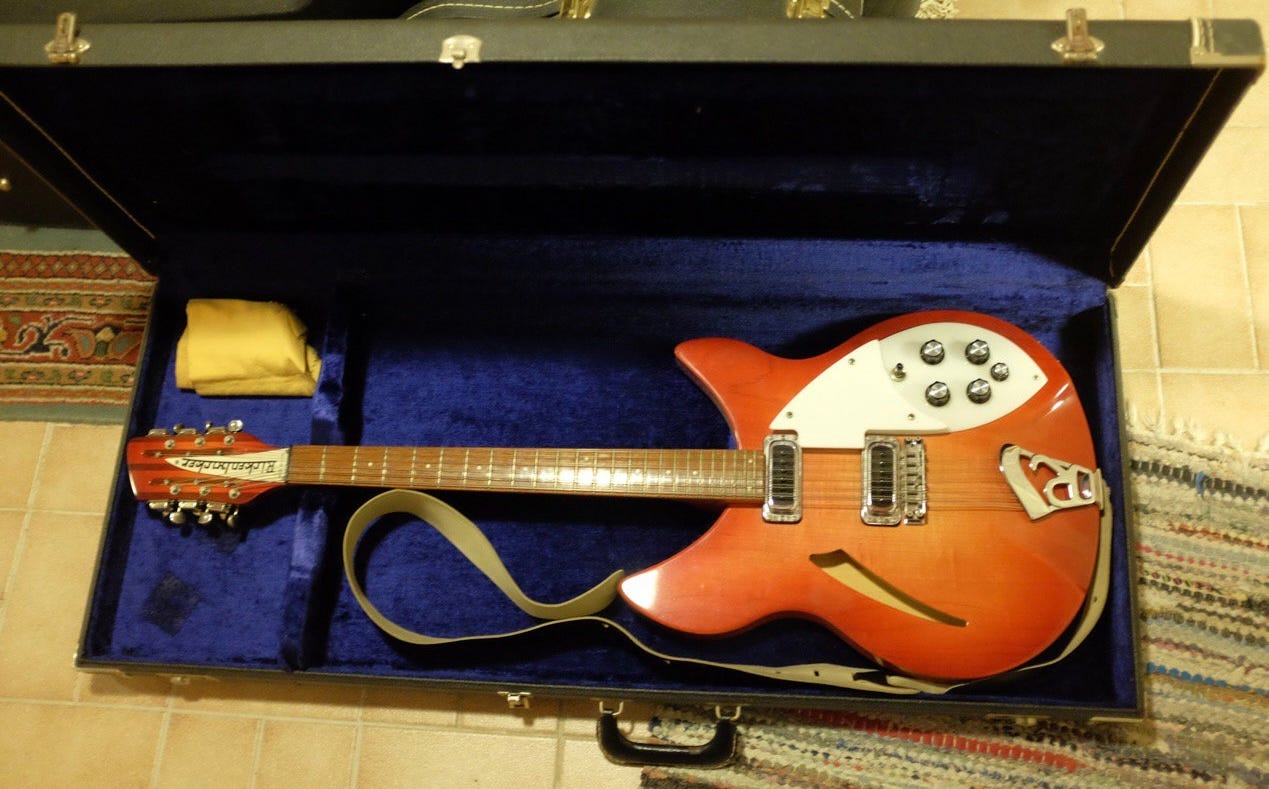

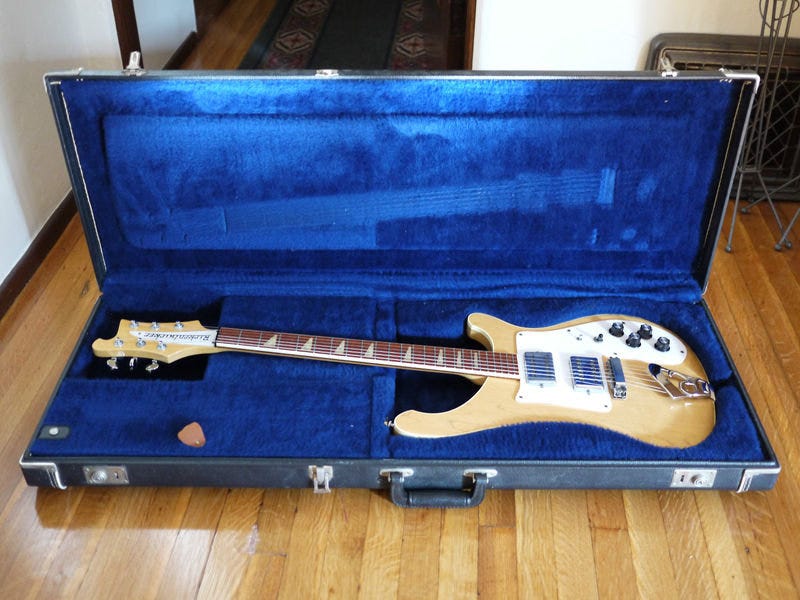
Nice work, Andy. I'm a bit dizzy after going through all that! I'm sure you know the feeling.
What a great read. I think lots of people have attempted to do this article, but here it is, well researched and fun to read and learn! Thanks so much! As an aside, my OS 5 and 8 string basses don't fit into standard 400x cases of the period, so I'm assuming those came with deluxe cases of their own as well.